The Cortinarius family, commonly known as webcaps, boasts an incredible diversity of colors, shapes, and sizes. This is a big family of mushrooms with some very dangerous members, like the deadly webcap. Many Cortinarius mushrooms are absolutely beautiful, like the violet webcap – there are actually over 100 purple webcap species. There is even a bright green webcap and several baby blue species in Australia. The majority of these mushrooms, though, are a shade of brown and rather nondescript.
Cortinarius identification in North America is an ongoing project, to say the least. Even the top mycologists focused on Cortinarius species labor to properly identify these mushrooms. This means that, although it’s relatively easy to determine whether a mushroom is a webcap, it is much more challenging to figure out which one it is.
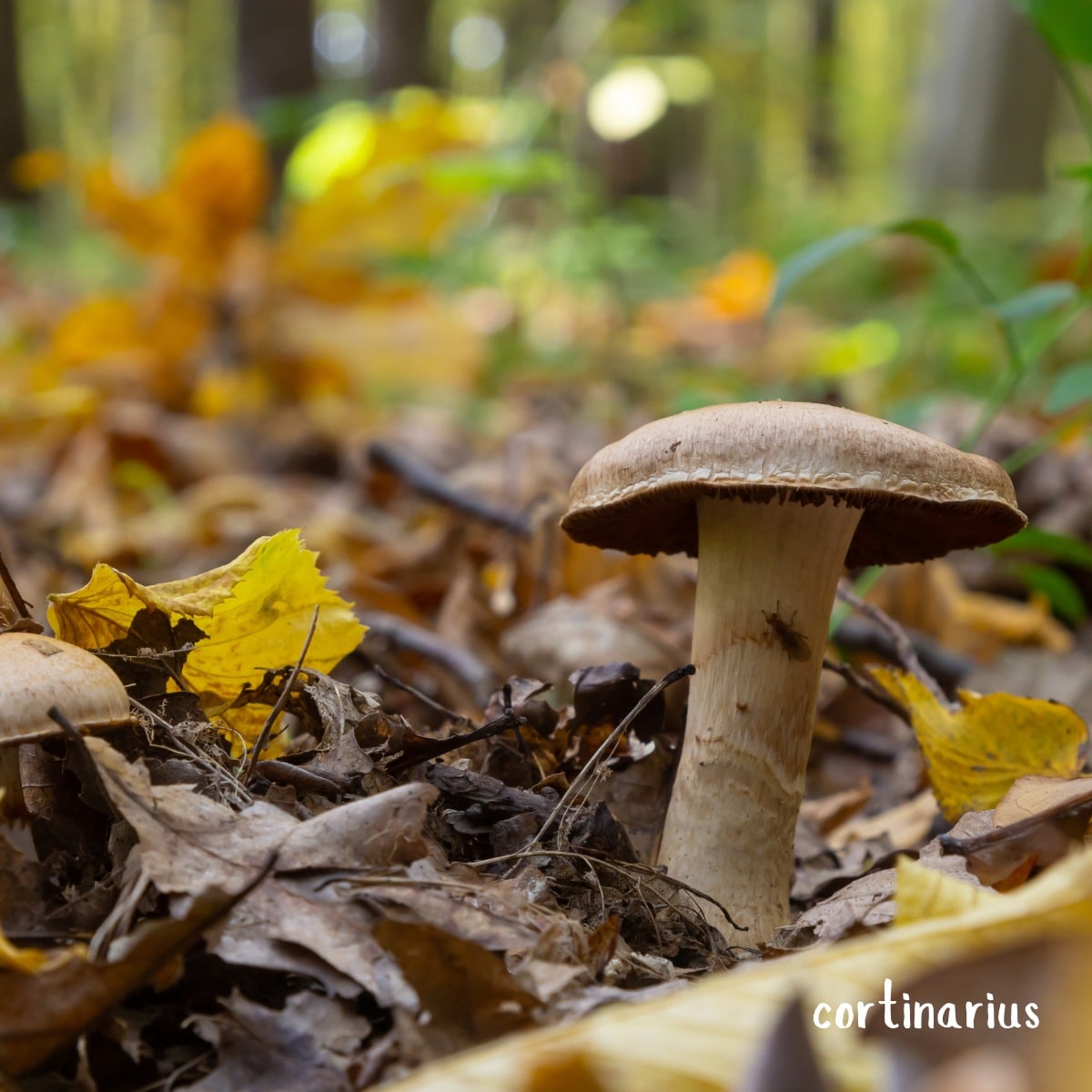
Overall, we do not recommend beginners forage these mushrooms, even the edible ones. There is too much room for confusion. Focus on identifying webcaps as a group and once you get good at figuring them out, start parsing out the species if you want. It takes a keen eye and lots of practice, but most expereinced foragers can identify a mushroom as in the webcap family pretty easily.
For an incredible (and detailed) documentation of Cortinarius species, check out the North American Cortinarius Collections put together by Shannon Adams. Also, Danny Miller’s documentation of Cortinarius in the PNW is astounding – a bit more scientific to read, but if you’re interested in Cortinarius mushrooms, you have to check it out. Michael Kuo’s dive into Cortinarius species is also thorough and enlightening.
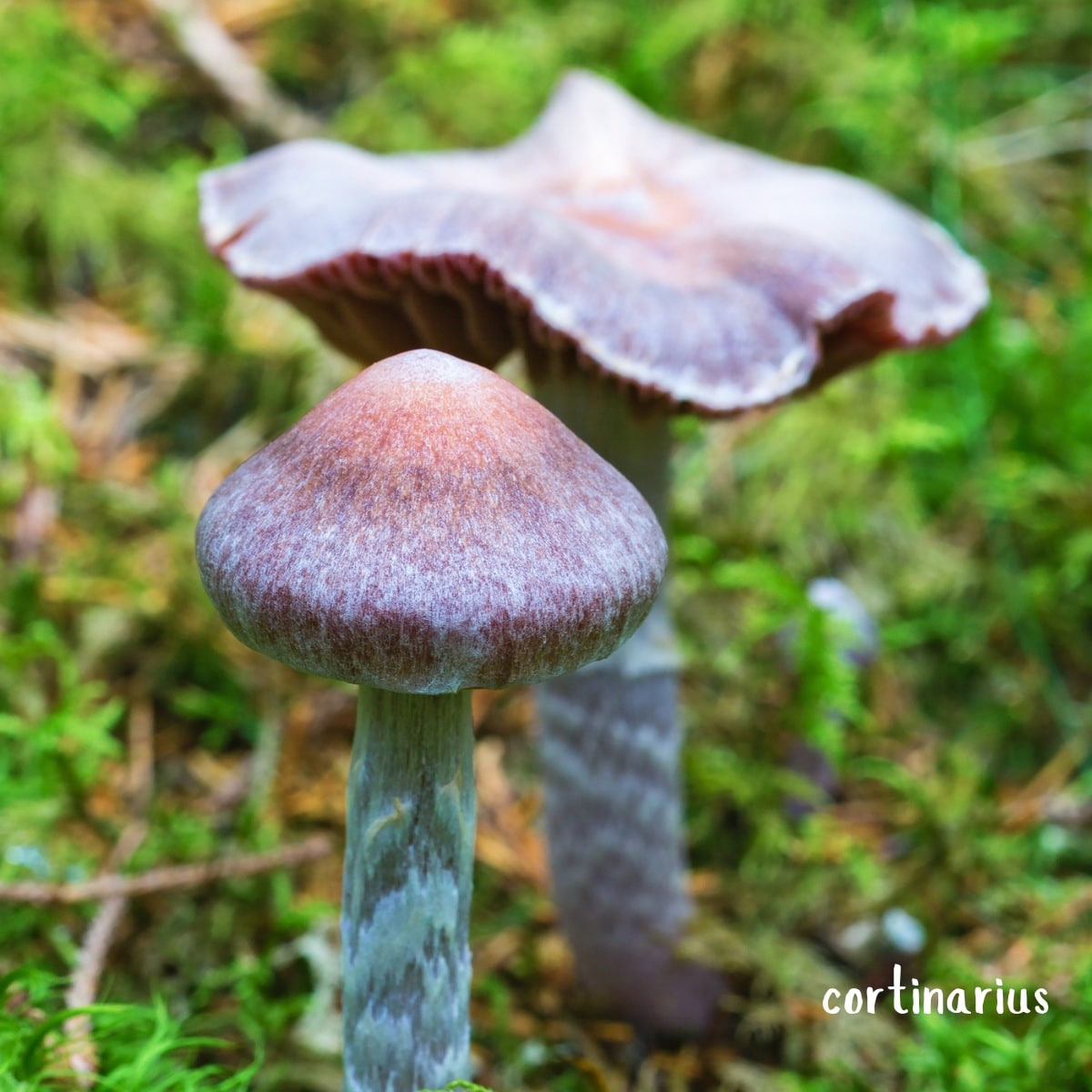
Jump to:
All About Cortinarius Mushrooms
The Cortinarius family, also known as webcaps, is the largest and most diverse group of mushrooms in the world, with over 2,000 species. These fungi are characterized by their rusty brown to cinnamon-colored spore prints and the presence of a cobweb-like partial veil (cortina) that covers the gills of young specimens.
Cortinarius mushrooms are mycorrhizal, forming symbiotic relationships with various trees, which makes them essential components of forest ecosystems. They range in color from vibrant purples and blues to more subdued browns and yellows. Identifying specific species within this genus can be challenging due to their incredible diversity and subtle differences. While some webcap species are edible, many are toxic, and a few are even deadly poisonous.
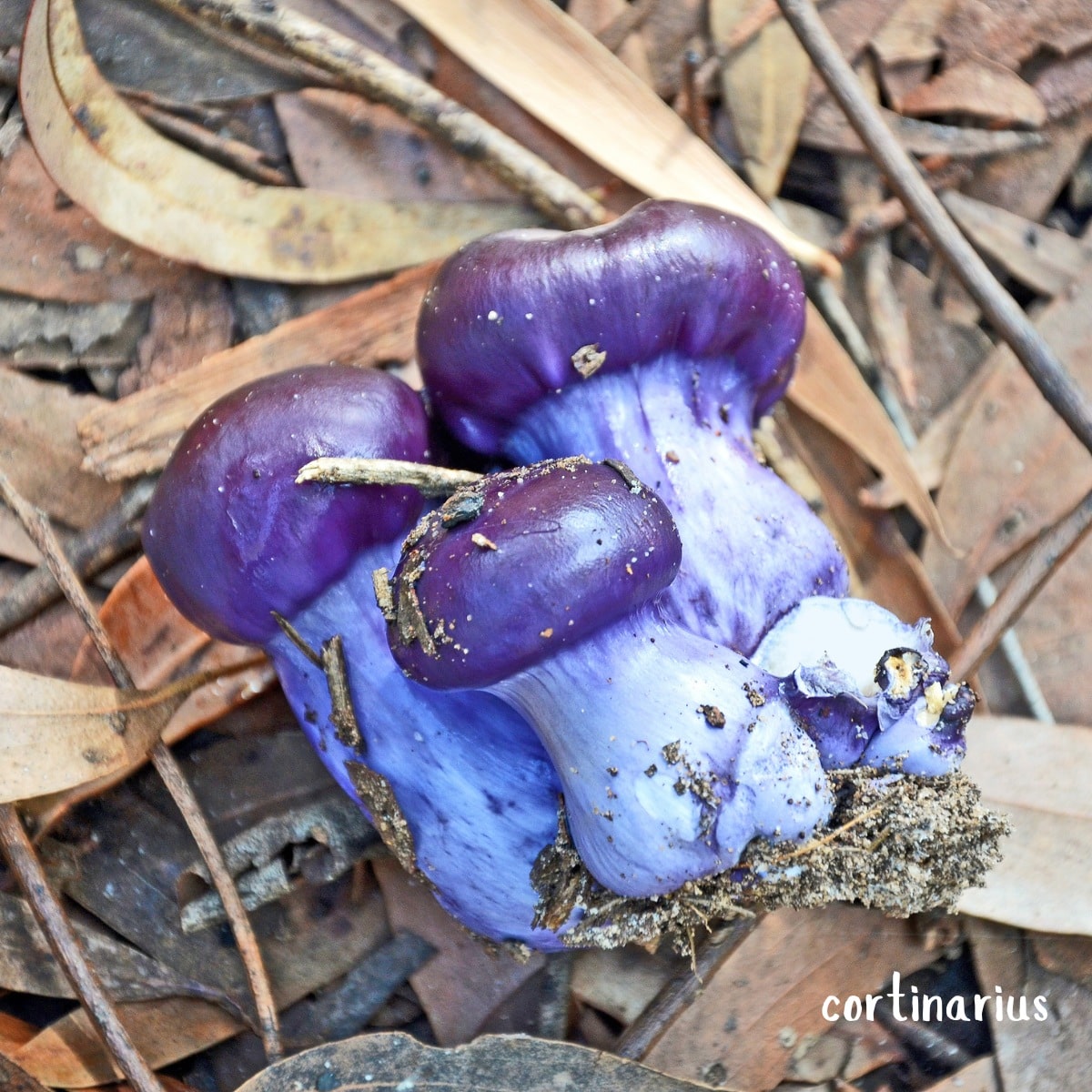
Cortinarius Mushroom Identification
Season
Seasons vary widely by species. There is not just one season in which they occur.
Habitat
Cortinarius mushrooms have a wide distribution across North America. They can be found from the eastern regions to the western coast and from the southern United States to the arctic zones of Canada and Alaska.
Webcaps form ectomycorrhizal relationships with a variety of tree species. They grow from the ground near their preferred trees. These mushrooms never grow from trees or on wood.
These mushrooms can be found in a wide variety of forest habitats. They fruit in coniferous, mixed conifer-broadleaf, and broadleaf forests. Some species, like Cortinarius caperatus, are widespread in northern North America’s boreal, hemiboreal, subalpine, and arctic zones. Others like Cortinarius albidipes have only been observed in the Northeastern USA, Québec, and the Rocky Mountains.
Certain species show more localized distributions. For example, Cortinarius anomalopacificus is moderately common in northern California coastal forests and Sierra Nevada foothills, while Cortinarius albomalus is known from interior Alaska and the Rocky Mountains.
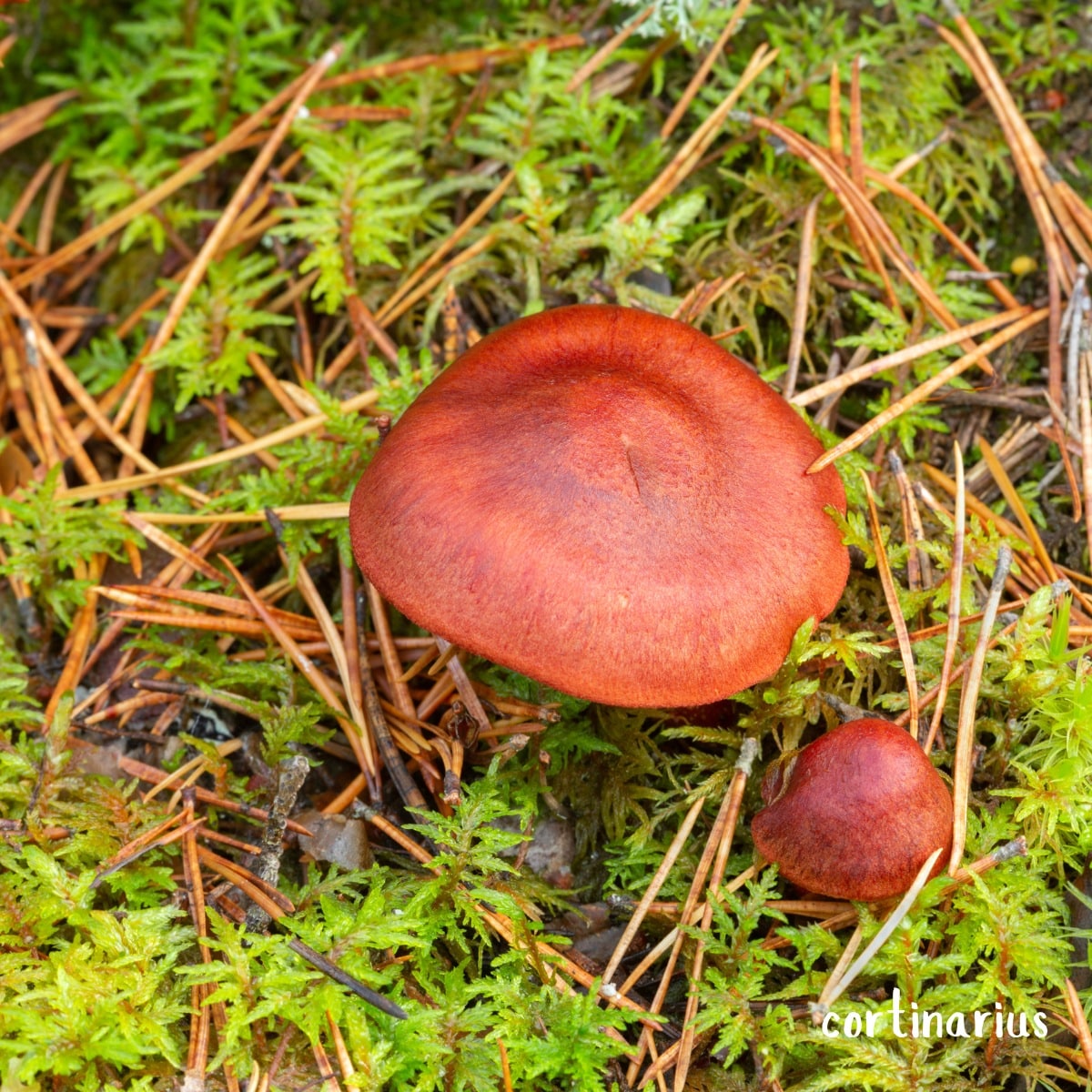
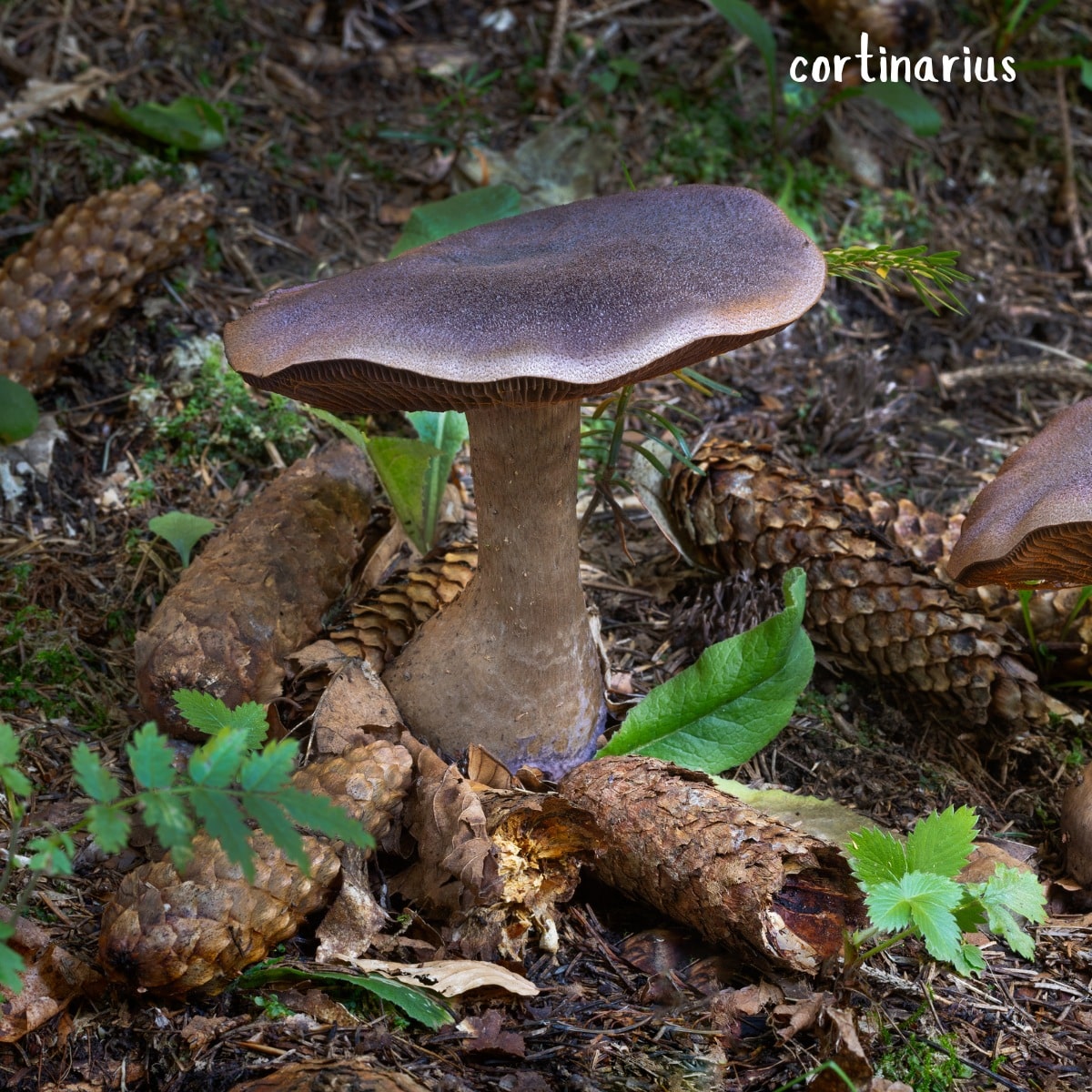
Identification
Cap
The caps of Cortinarius mushrooms may have a slimy texture or may be dry. If they’re slimy, this is a helpful identifier for many species within the genus. The cap’s appearance can vary significantly among different species, though. Many Cortinarius mushrooms are brown and rather bland looking – there are so many shades of brown webcaps! Others in this family are beautiful violet to deep purple and really stand out in the woods. The cap color, on its own, is rarely enough to make an identification. Except with the purple ones, nothing else quite looks like those.
Gills
One of the most distinctive features of Cortinarius mushrooms is the presence of a cortina, a web-like veil that covers the gills of young specimens. This delicate structure gives rise to the common name “webcap.” With very young mushrooms, you can’t see the gills unless you pull off the cortina. As the mushroom grows, the cortina often disappears or collapses against the stem, creating a ring zone around the upper stem.
The gills themselves are usually closely spaced and attached to the stem, ranging in color from pale to rusty brown, depending on the species and age of the mushroom. The gills usually change color as the mushroom ages, often darkening due to the maturing spores.
Cortinarius gills have a lot of symmetry. There are always long gills and short gills and they are arranged in perfect patterns with a nice amount of space between them. The gills are rarely crowded or jagged and they don’t run down the stem. This is one way cort species are readily recognizable; their gills look perfectly arranged.
Stem and Veil
The stem may be equal in width throughout, club-shaped (clavate), or have a swollen base with a distinct rim (marginate). To properly identify a Cortinarius specimen, it’s crucial to carefully dig up the entire mushroom, including the base of the stem.
In many cases, remnants of the partial veil (cortina) may be present on the stem as a ring – it looks a bit like a water line. Other species have a cortina that is sheathed or “peronate”; it looks as if the stem is wearing a tight-fitting sock. This feature is also an important factor in species identification.
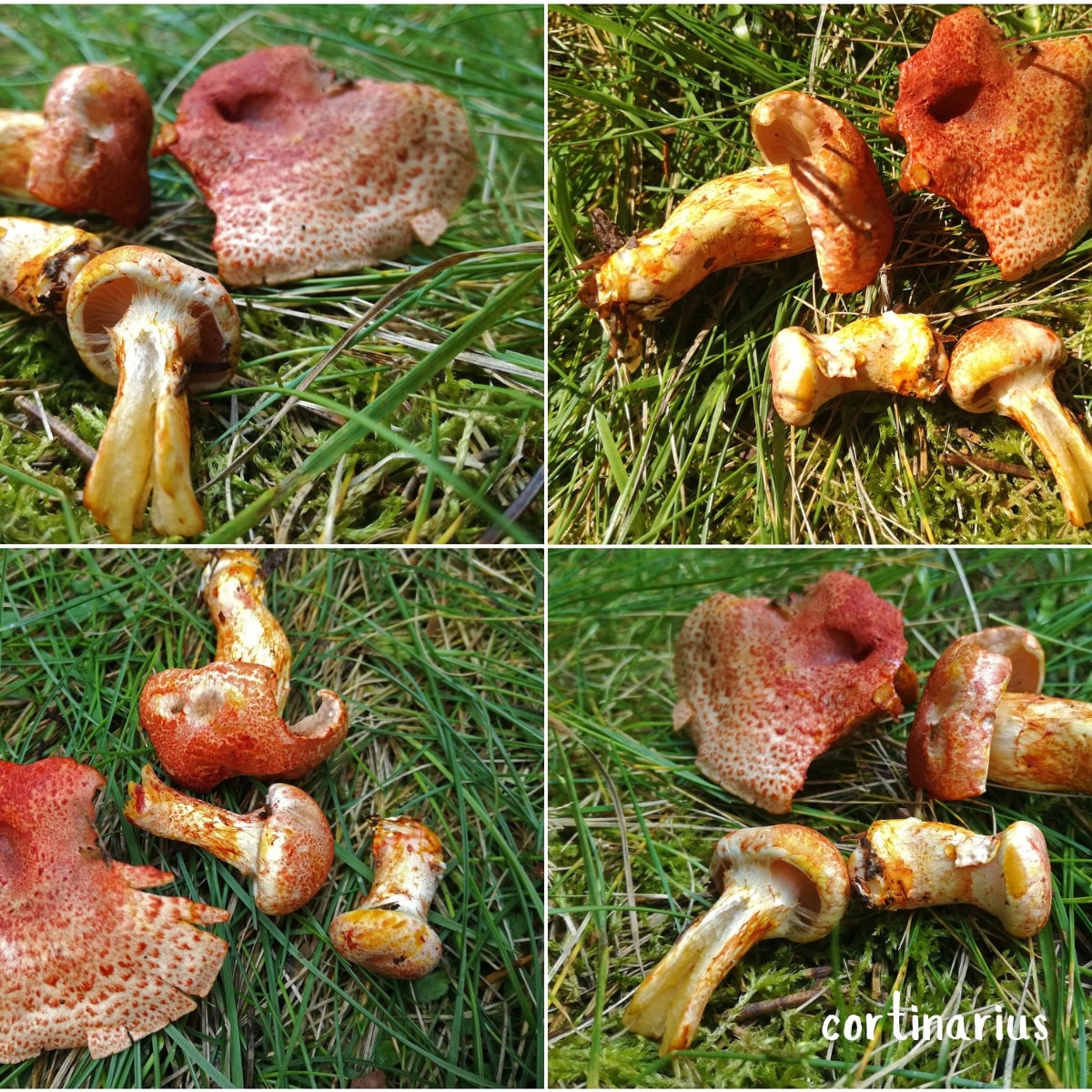
Flesh
Flesh color varies with species. Generally, it does not change color when cut, though with some species, the flesh may darken when exposed to air.
Spore Color
Perhaps the most defining characteristic of Cortinarius mushrooms is their rusty brown spore print. If you ever have any questions about whether you’ve found a webcap mushroom, do a spore print.
To accurately identify Cortinarius species, microscopic examination is often necessary. Spore morphology, including shape, size, and degree of ornamentation, plays a crucial role in species determination.
The rusty spore print of Cortinarius sets them apart from other mushroom genera. For example, blewits (Lepista nuda) have a light creamy pink spore print, while members of the Agaricus family produce chocolate brown spores. Russula and Lactarius species have white or light-colored spore prints, Stropharia mushrooms have purple-black spores, and genera like Armillaria, Lepiota, Tricholoma, and Hygrophoraceae all have white spore prints.
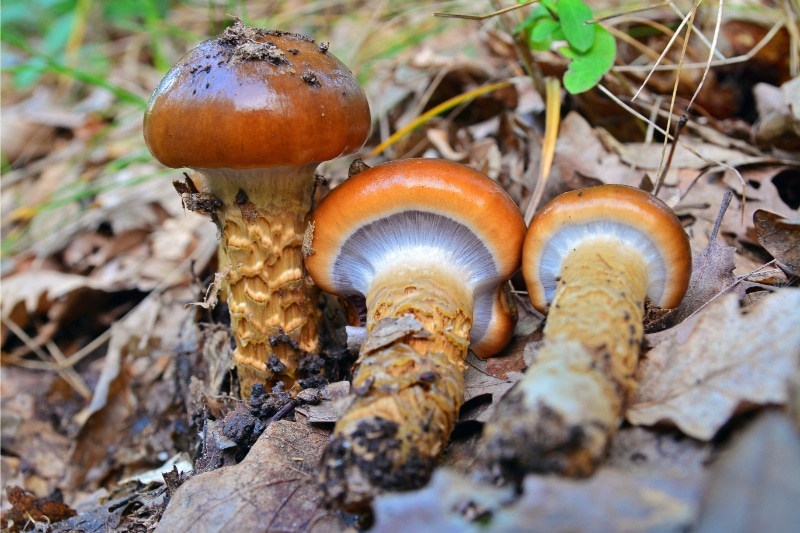
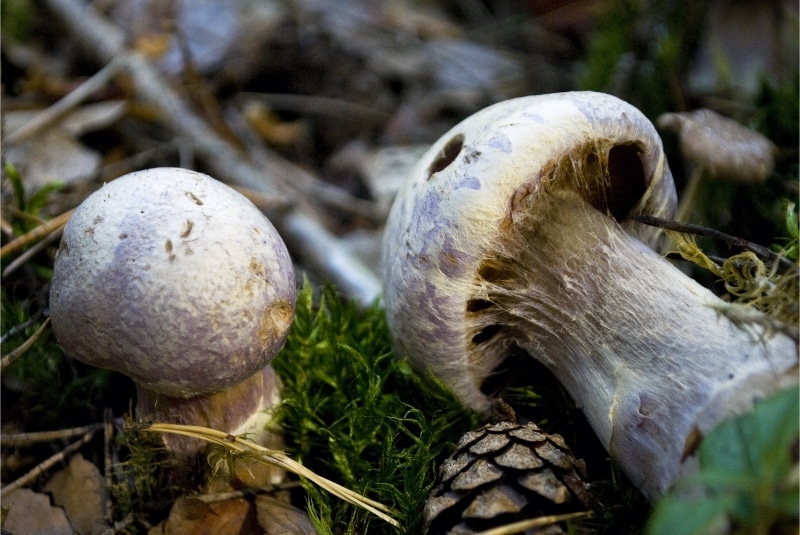
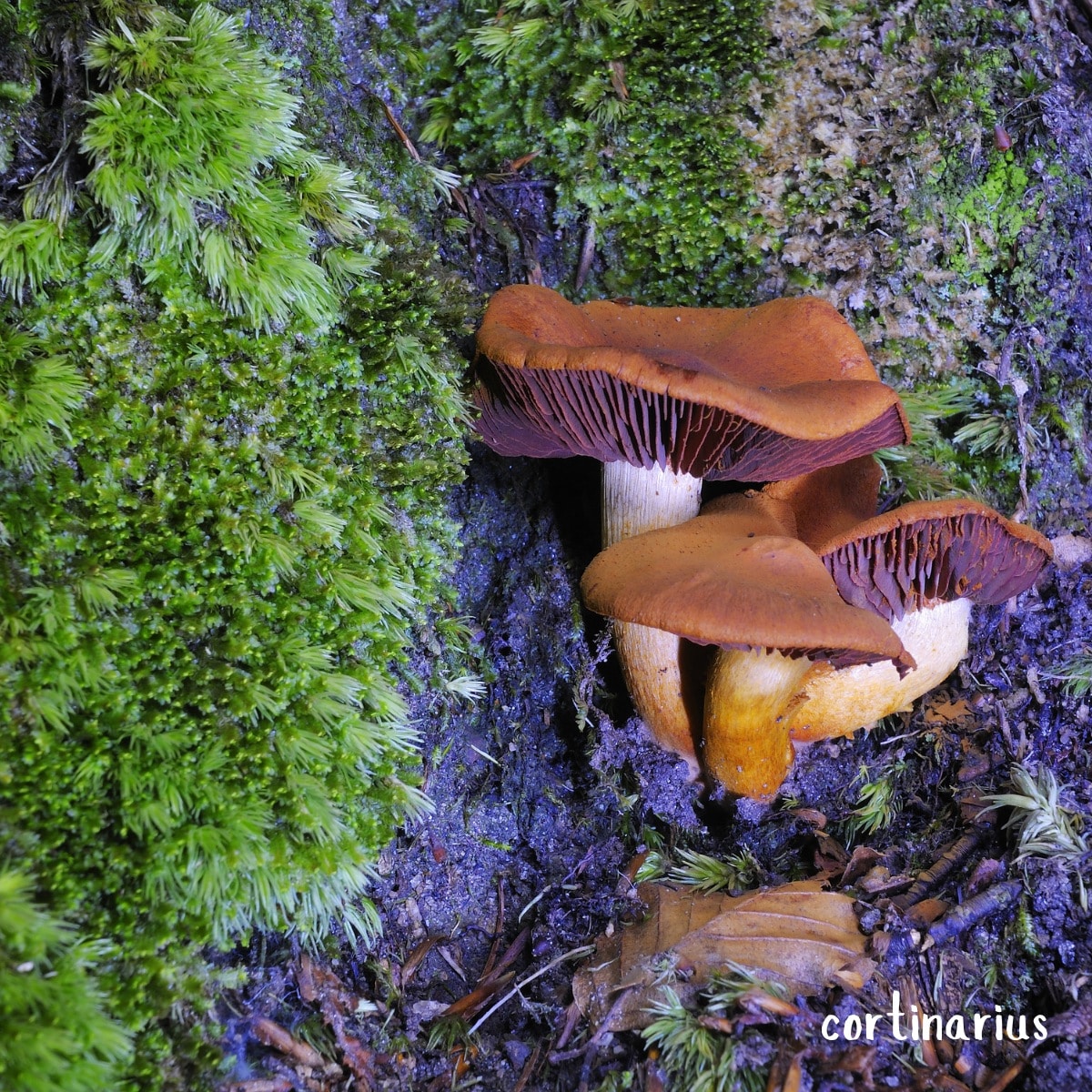
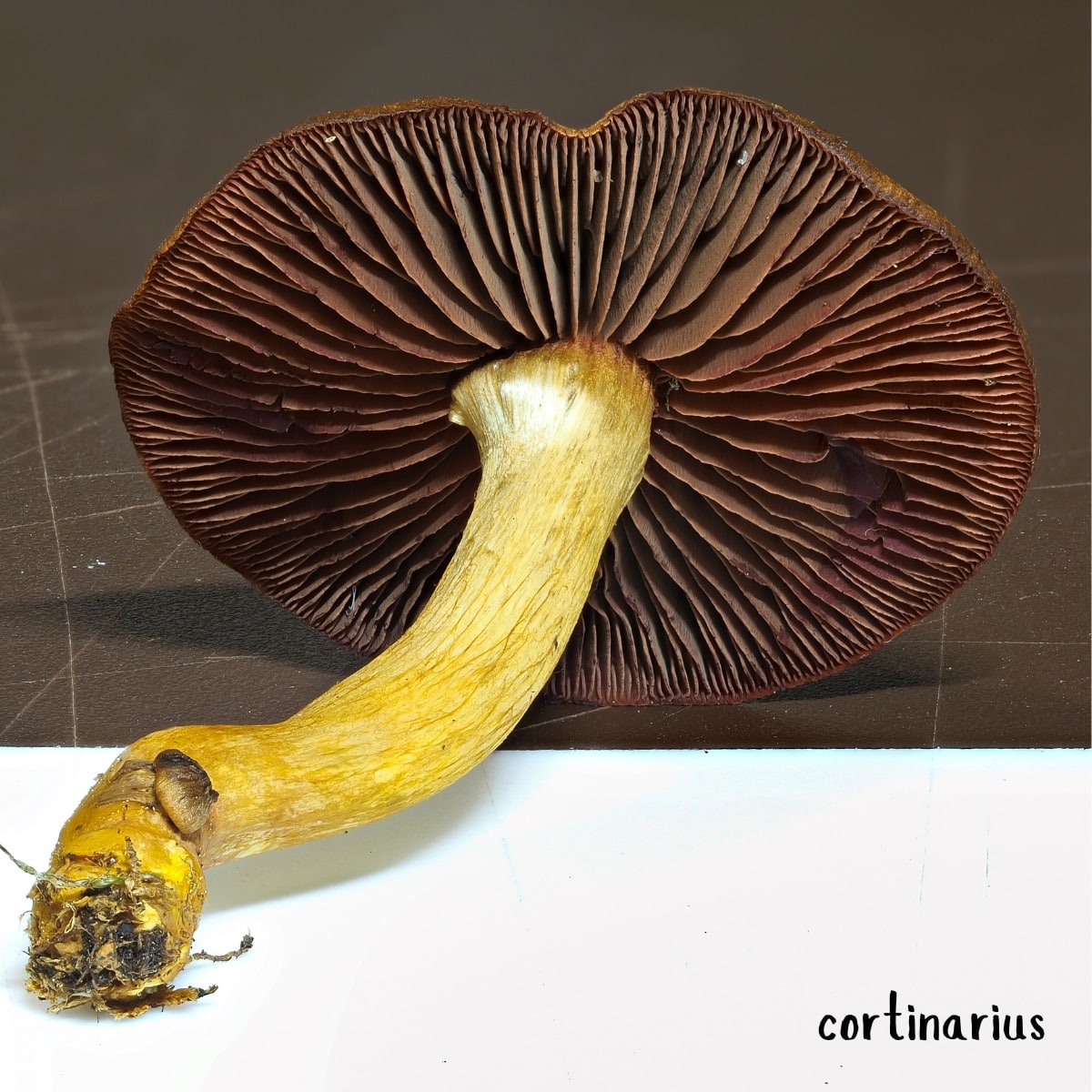
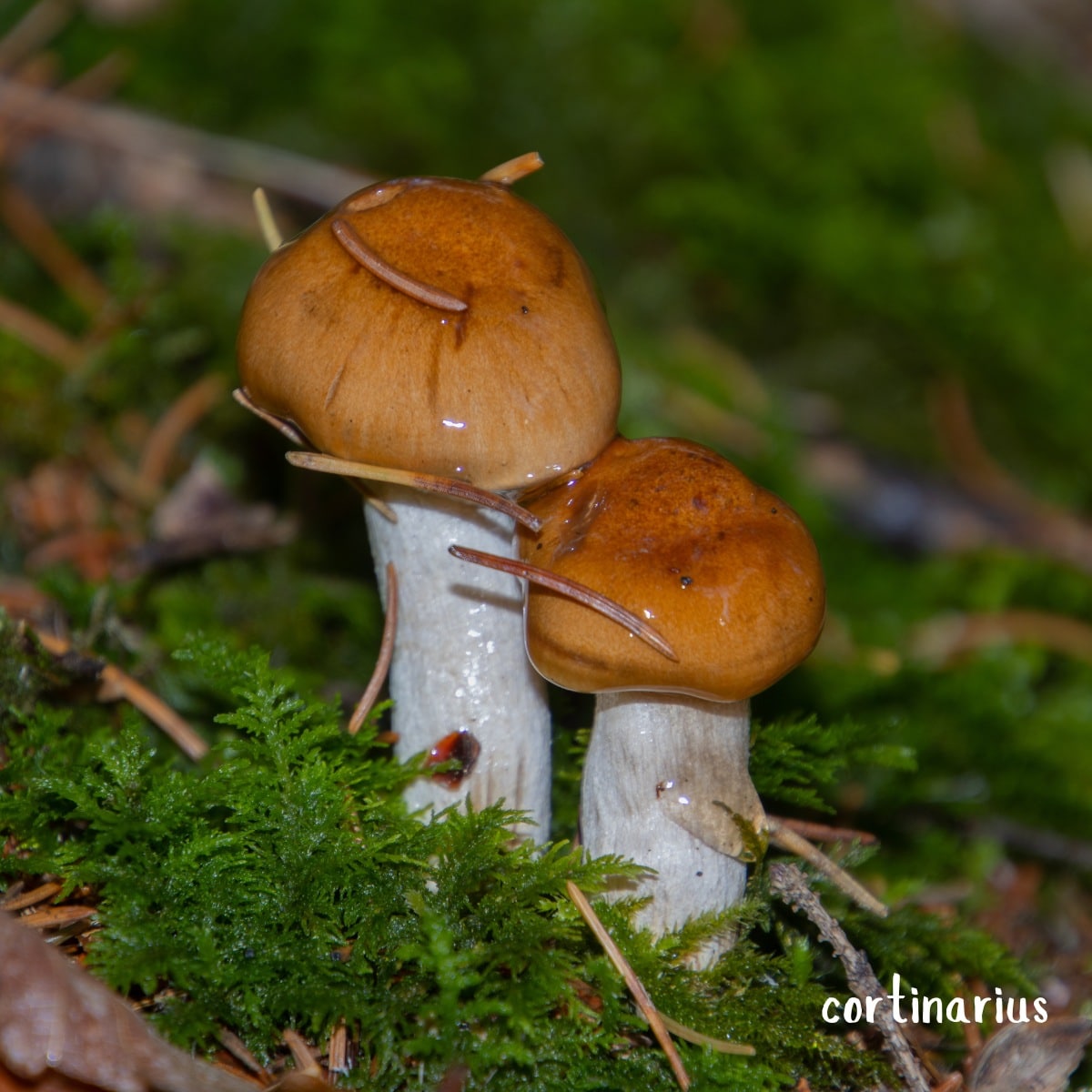
Edible Cortinarius Mushrooms
Gypsy Mushroom (Cortinarius caperatus)
The gypsy mushroom, also known as the wrinkled cort, is a distinctive edible mushroom species in the genus Cortinarius. This mushroom is medium to large in size with a cap between 2-4 inches in diameter. The cap is rounded when young but flattens out with maturity. It has a distinctive wrinkled or furrowed surface that gives it a weathered appearance and is often adorned with white veil remnants. Its color ranges from pale ochre to tawny brown, sometimes with a slight olive tinge.
The stem is sturdy and cylindrical, often with a prominent ring or cortina around the upper stem. The gypsy mushroom has pale, crowded gills that mature to a rusty brown color. This mushroom is found primarily in coniferous and mixed forests in northern North America and grows on the ground among moss or needle litter. The gypsy mushroom has a mild, pleasant taste.
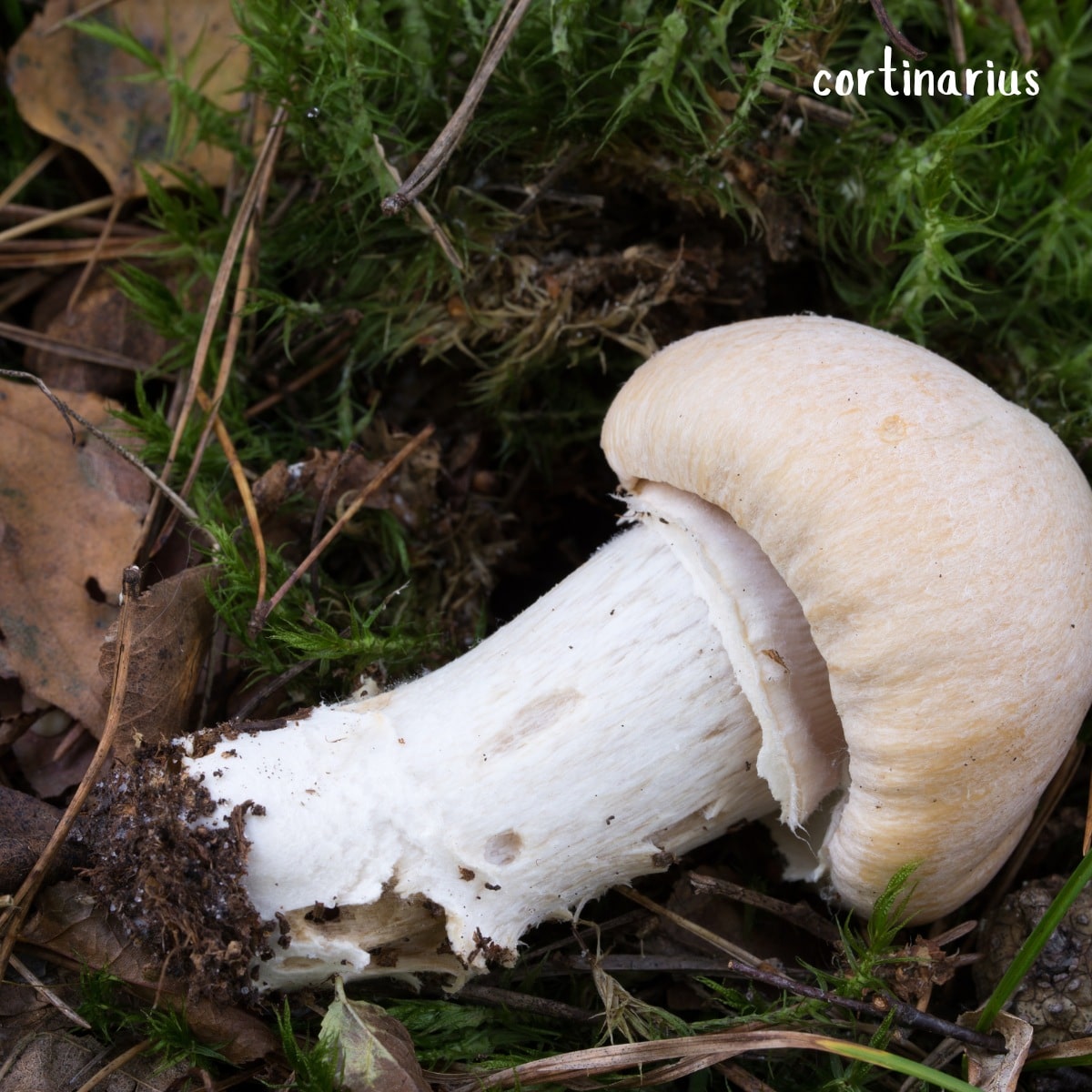
Bracelet Cortinar (Cortinarius armillatus)
The bracelet cortinar, also commonly known as the Red-banded Cort or Red-girdled Cort, is associated with birch trees and is relatively common in northern forests where birch trees grow. The cap typically measures 2 to 4 inches (5 to 10 cm) in diameter and has a rounded to slightly flattened top. The cap expands with age to flatten out more. Often, the center of the cap is slightly upraised like a button. It ranges from reddish-brown to orange-brown.
One of the most notable features of this mushroom is its stem, which can grow up to 4 to 6 inches (10 to 15 cm) tall. The stem is adorned with distinct, bright red-orange bands or girdles against a paler background, giving the mushroom its common name. These bands are actually remnants of the partial veil that covered the gills when young. The gills are crowded and start out pale cinnamon but darken to rusty brown.
Interestingly, this mushroom contains trace amounts of orellanine but at levels less than 1% of those found in toxic species like Cortinarius rubellus. No poisonings have been documented from C. armillatus.
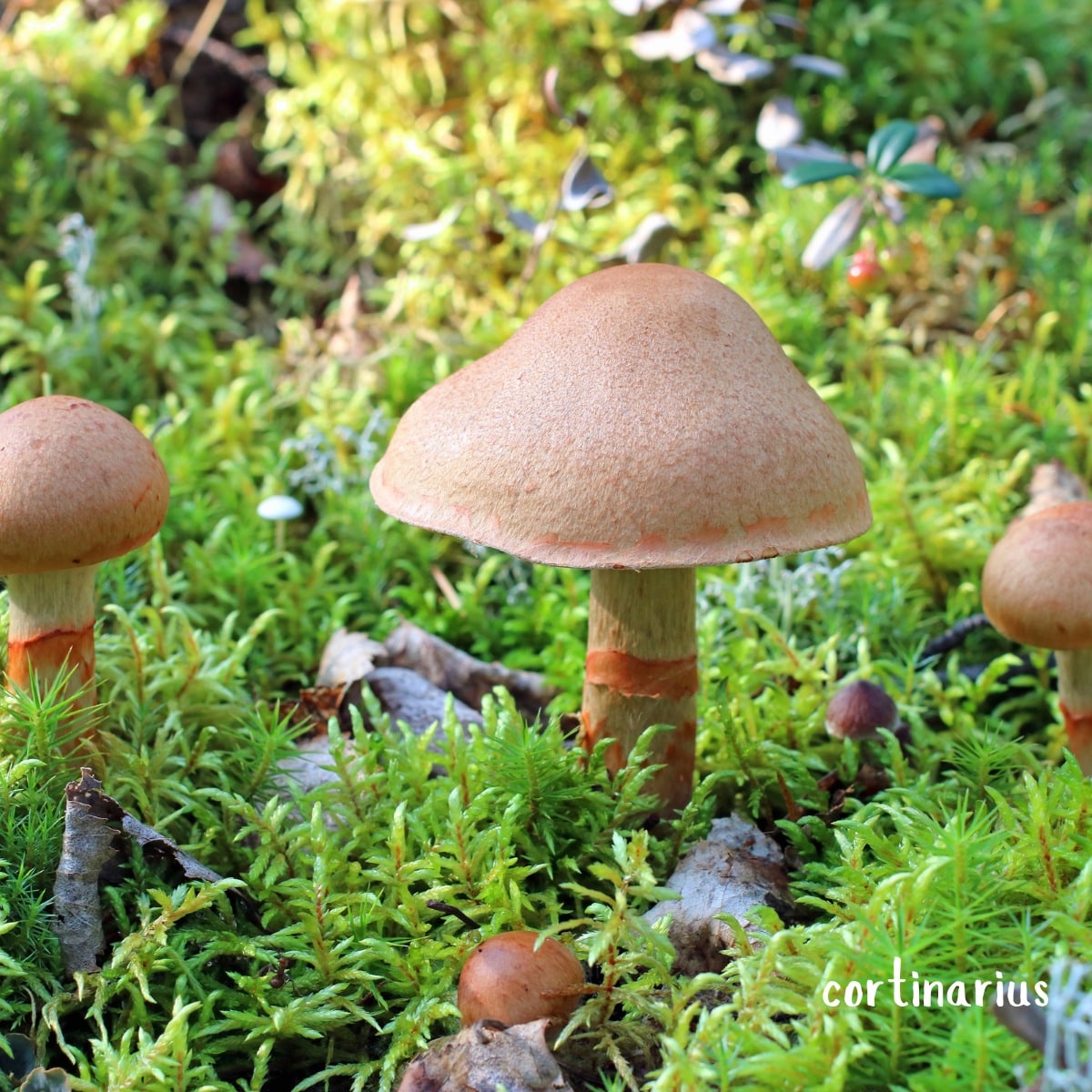
Toxic Cortinarius Species
Several North American Cortinarius species are known to be toxic, with some capable of causing severe health issues.
Deadly Webcaps (Cortinarius rubellus)
As the common name makes clear, the deadly webcap is a very dangerous Cortinarius. It is also known as the Fool’s Webcap because it can be confused with edible species, thus fooling the forager. This species is found in Washington, Canada, and possibly Maine. It is responsible for the second documented orellanine poisoning in North America. This species is associated with coniferous forests and is also known by synonyms C. speciosissimus, C. orellanoides, and C. rainierensis.
A second deadly webcap species also exists in North America. Cortinarius orellanosus, a newly described species, has been implicated in causing renal failure after ingestion. It was first described from specimens collected in western Michigan in 2010 and was responsible for the first documented orellanine poisoning in North America. To date, it has only been found in Michigan but may occur elsewhere with hardwoods in the Midwestern and Northeastern states.
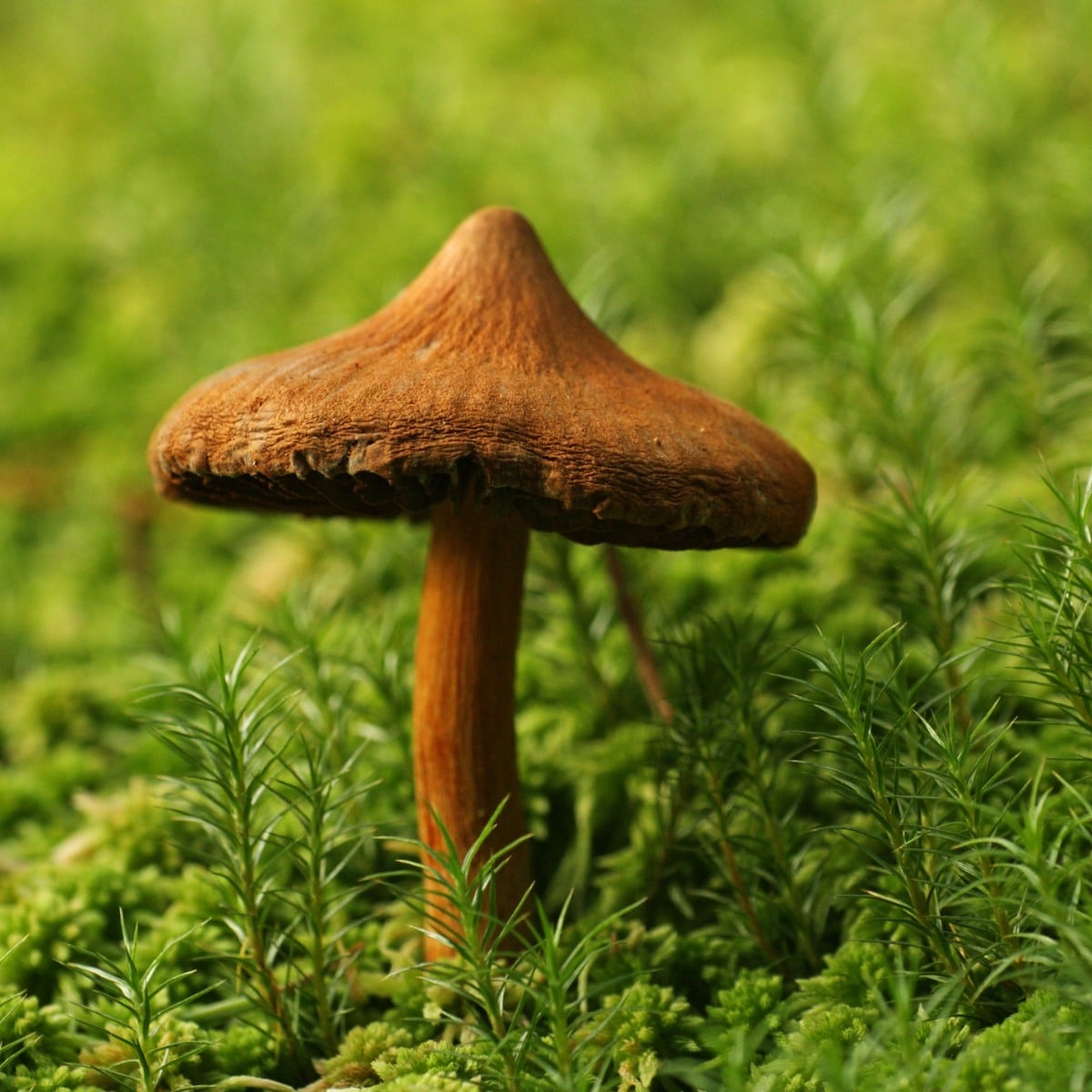
These two webcaps look almost identical and can only be differentiated by tree association. Cortinarius rubellus grows with conifers and Cortinarius orellanosus fruits with oaks and other hardwoods.
Deadly webcaps have rounded brownish-orange caps that spread out with age. The center of the cap usually has an uplifted center, like a button or “nipple.” The gills are yellowish when young but change to deep rusty brown with age. Deadly webcap stems are the same color as the cap, slightly bulbous, and have fragments of the cortina around the entire thing. The stem often has a snakeskin-like pattern.
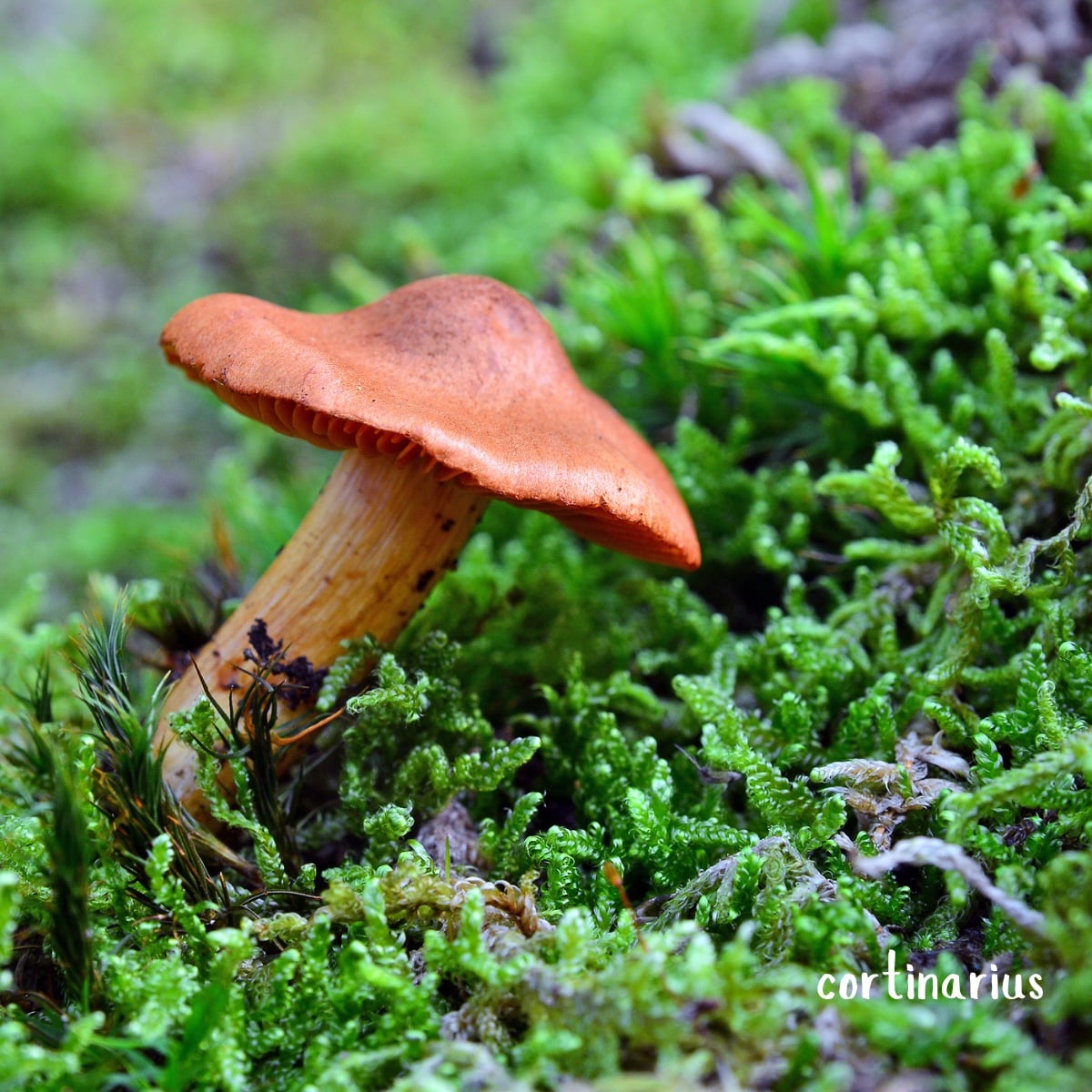
Symptoms of Orellanine Poisoning:
The toxicity of these species is very dangerous. Orellanine causes kidney damage and, eventually, kidney failure. The kicker, though, is that the symptoms often don’t show up for 2-3 days or even 1-2 weeks. This latency means that it’s hard to pin the symptoms on the mushroom or even make the correlation until it’s too late and the person is in kidney failure.
Initial symptoms of orellanine poisoning include flu symptoms, like headaches, nausea, vomiting, and stomach pain. This is followed by signs of kidney damage, including frequent urination, thirst, and pain around the kidneys. The later stages are nonexistent urination and decreased thirst. This is the kidneys failing, and death will happen if not treated.
There is no known treatment and care focuses on supportive, dialysis, and kidney transplant if needed. Interestingly, orellanine is currently being studied as a potential treatment for renal cancer.
This is a great retelling of an unfortunate case of mistaken mushroom identity and how the deadly webcap almost killed a famous author.
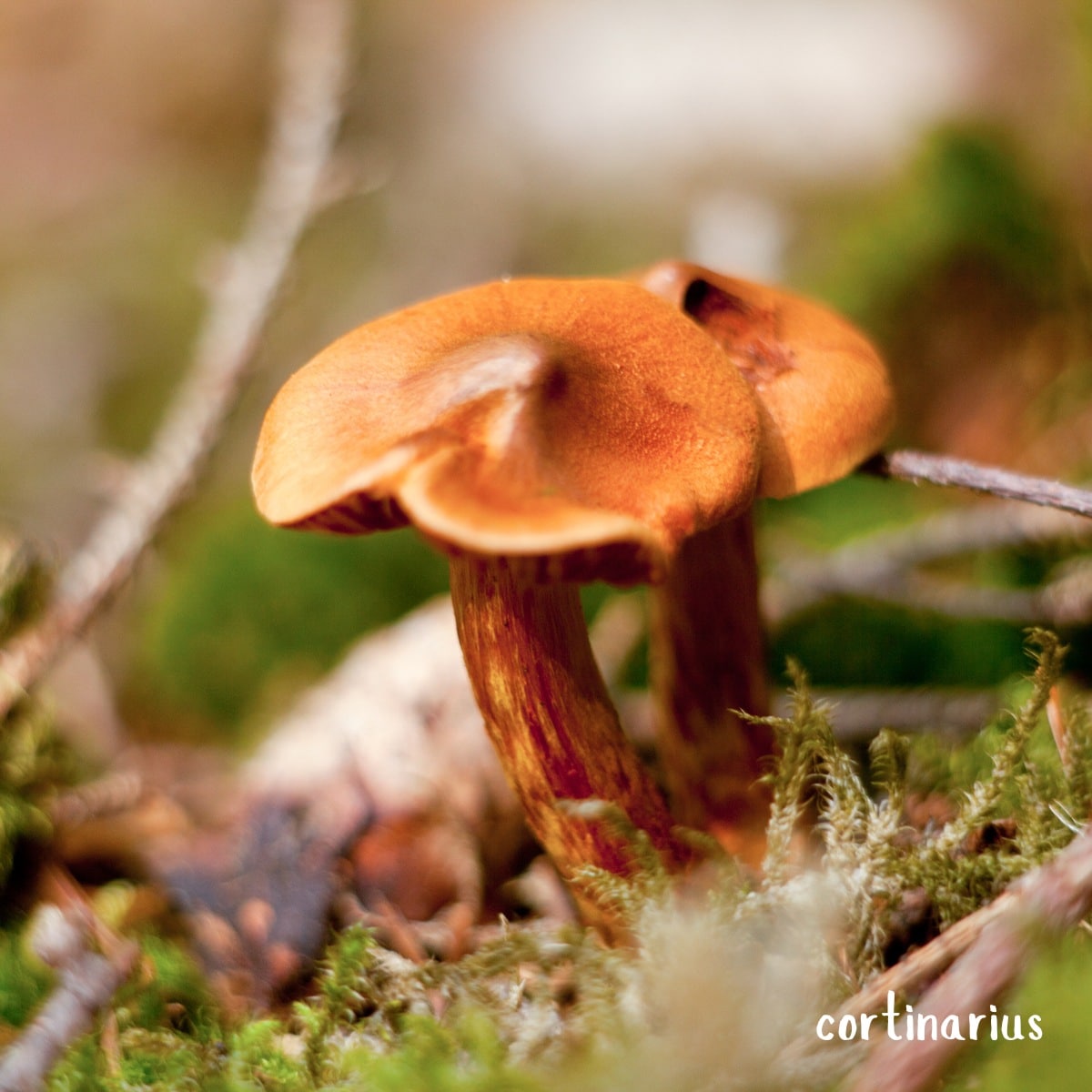
Rare and Interesting Cortinarius Species
North America is home to several beautiful and unique Cortinarius species. As you can see from the following list, the colors vary significantly in this family of mushrooms. These species represent just a fraction of the incredible diversity within the Cortinarius genus in North America.
Violet Cort (Cortinarius violaceus)
This beautiful Cortinarius, commonly known as the violet webcap or purple cort, is easily recognizable by its deep purple-to-violet coloration that covers the entire fruiting body. The violet cort cap measures 2 to 4 inches in diameter and starts out rounded before flattening with age. Often, there is a slight central depression in the cap. Its surface is dry and covered with fine, fibrous scales, which gives it a somewhat velvety texture.
The stem measures about 2 to 4 inches in length, is solid and cylindrical, and sometimes slightly bulbous at the base. It shares the same vibrant purple color as the cap and has silky fibers along its length. The gills are attached to the stem and widely spaced. They start out purple but darken to rusty brown as the spores mature. Young specimens have a cortina, which leaves behind a faint ring zone on the stem as it matures. The flesh of the violet cort is pale lilac to grayish-purple and has a mild, slightly radish-like odor and taste. This mushroom is found in both deciduous and coniferous forests.
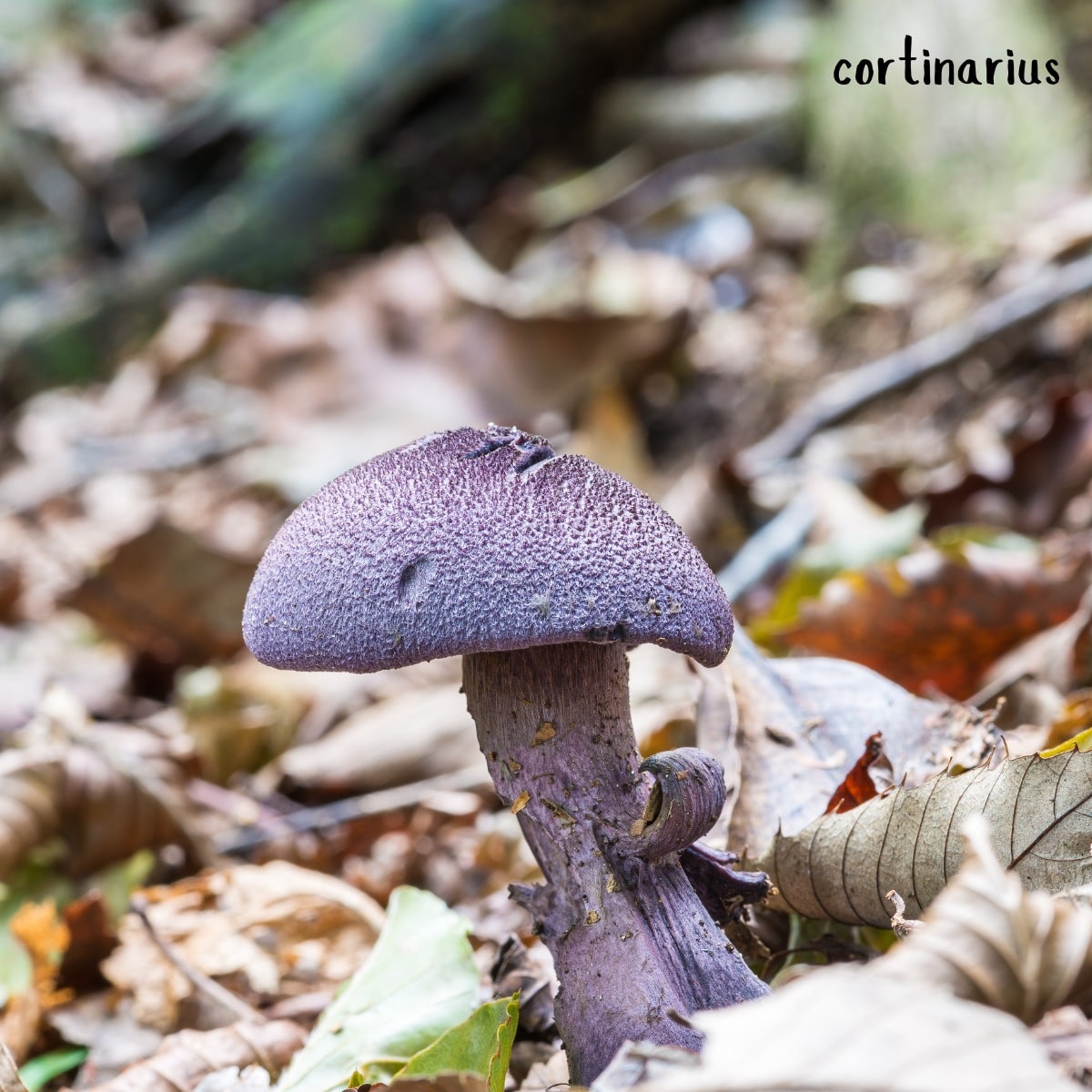
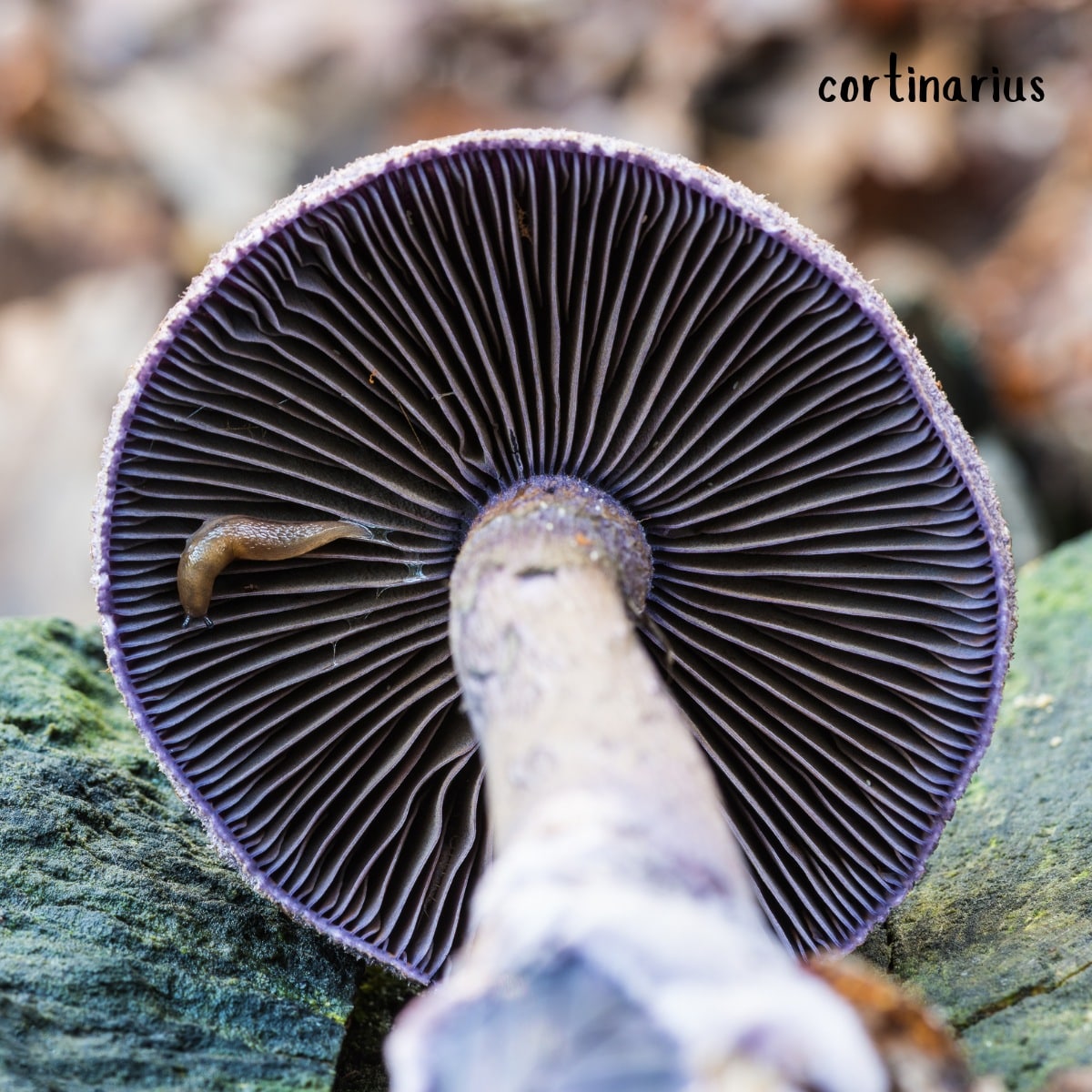
Goatcheese Webcap (Cortinarius camphoratus)
A key identifying feature of this mushroom is its strong, unpleasant odor, often described as similar to rotten potatoes or burnt horn, which becomes more pronounced as the mushroom ages or is dried. The cap typically measures 2 to 4 inches in diameter, is rounded, and often has a central upraised center called an umbo. It is white/buff with tints of lilac and covered with tiny fibers matted on the surface. The gills are crowded and initially lilac but turn rusty brown as the spores mature. The stem is 2 to 4 inches long, with a bulbous base and a pale lilac to brownish color. The flesh is whitish to pale lilac, and the spore print is rusty brown. It is found in coniferous forests, particularly under spruce trees.
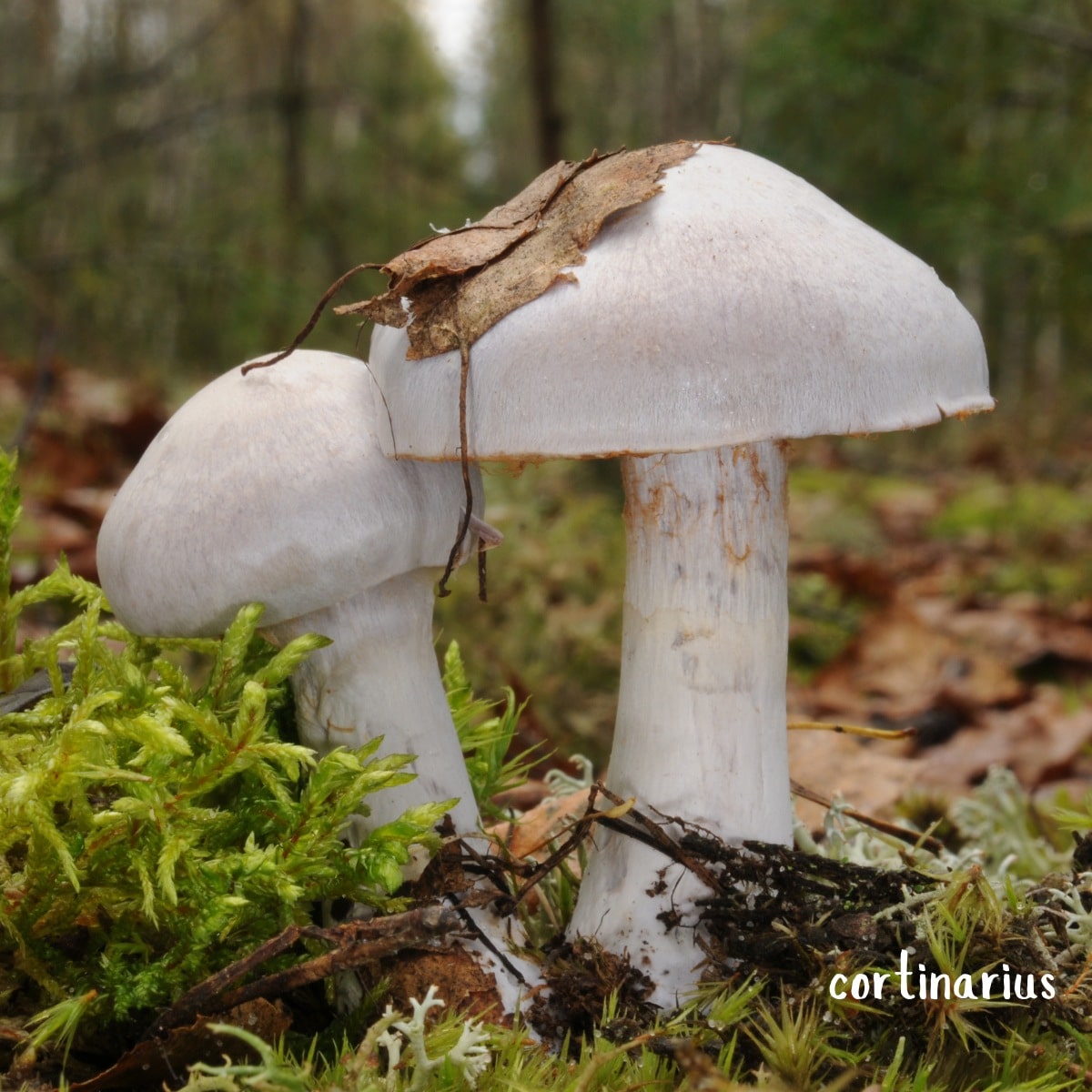
Pointed Cortinarius (Cortinarius vanduzerensis)
This is a striking and relatively rare mushroom that only occurs in the Pacific Northwest. Its cap measures between 2 to 4 inches in diameter and is reddish-brown to cinnamon-colored. The cap is rounded to slightly flattened in shape and often develops a slight umbo (a raised central bump) as it matures. Its surface is notably viscid when moist. The gills are initially pale lilac to violet but change to rusty brown as the spores mature. The stem, measuring about 3 to 5 inches in length, is cylindrical and often slightly bulbous at the base. It shares the lilac to violet coloration of the young gills and has remnants of a cortina (a cobweb-like partial veil). This species is known for its association with coniferous trees, particularly in the coastal forests of the Pacific Northwest.
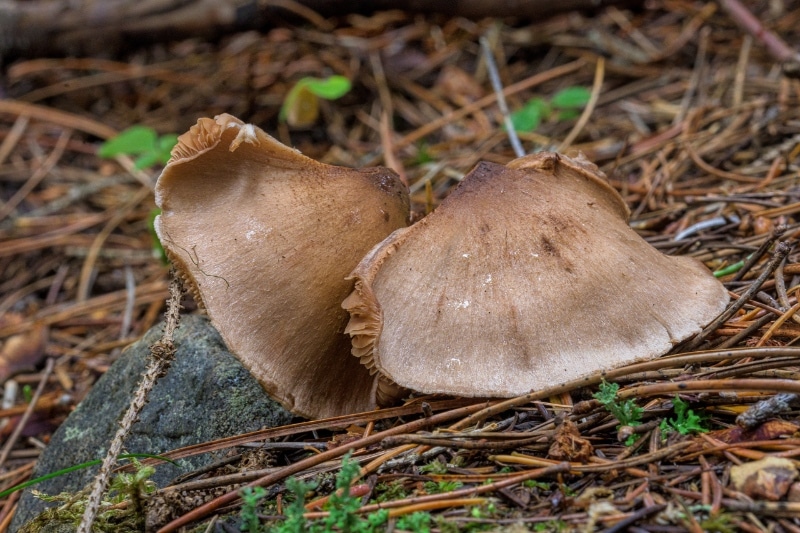
Slimy Webcap (Cortinarius delibutus)
The cap of this fungus typically measures 1.5 to 3 inches in diameter and is notably slimy or viscid when moist. It starts round in shape, gradually flattens with age, and has a pale yellow to ochre coloration. The cap’s edges often have remnants of the veil, appearing as small, whitish fragments. The stem, measuring about 2 to 4 inches in length, is cylindrical and slightly bulbous at the base. It is lighter colored than the cap and also is slimy. The gills are initially pale lilac or clay-colored and darken to rusty brown with age. The cortina leaves a faint ring zone on the stem. The flesh is whitish to pale yellow, and when cut, it may show a slight lilac tint at the stem base.
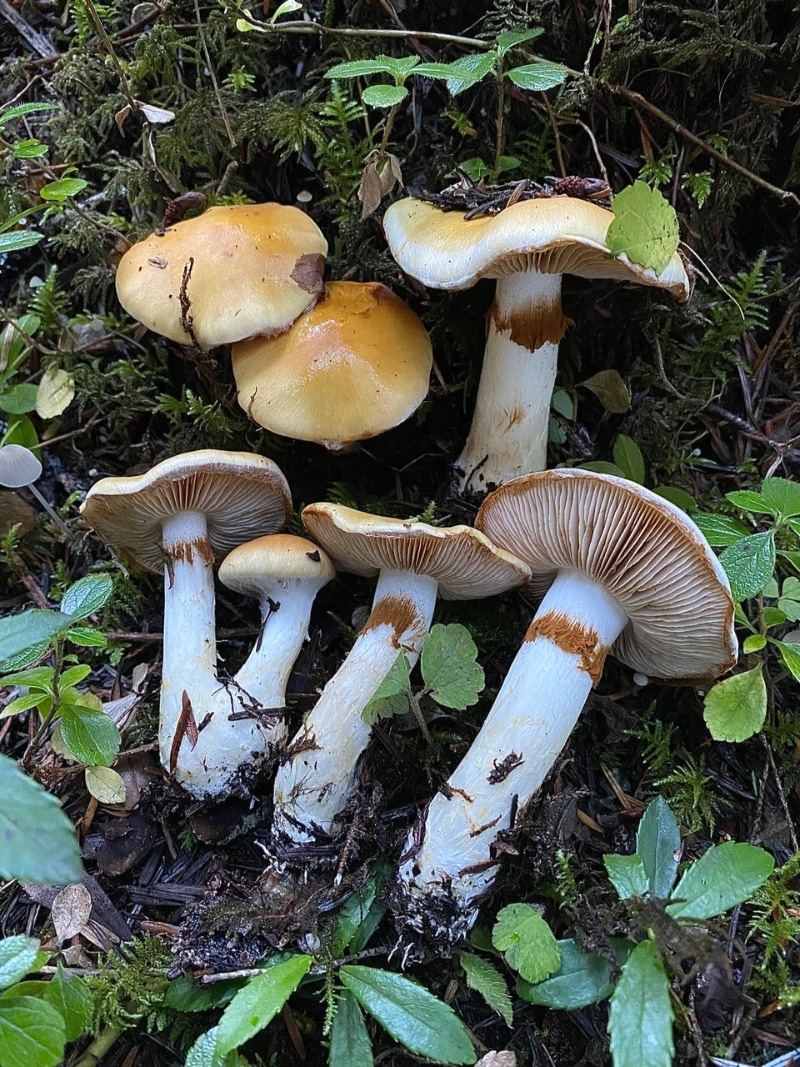
Pelargonium Webcap (Cortinarius flexipes)
A key identifying feature of this species is the strong pelargonium-like odor (similar to geraniums) when the flesh is crushed. Its cap typically measures 0.8 to 2 inches in diameter and is initially bell-shaped before flattening with age. The cap color ranges from reddish-brown to dark brown, often with a lighter edge. The stem is slender, measuring 2 to 3.5 inches in length. It has a pale color at the top, becoming brownish towards the base, and is adorned with silky fibrils. The gills are initially pale, turning rusty brown as the spores mature. The cortina leaves a ring mark around the upper stem.
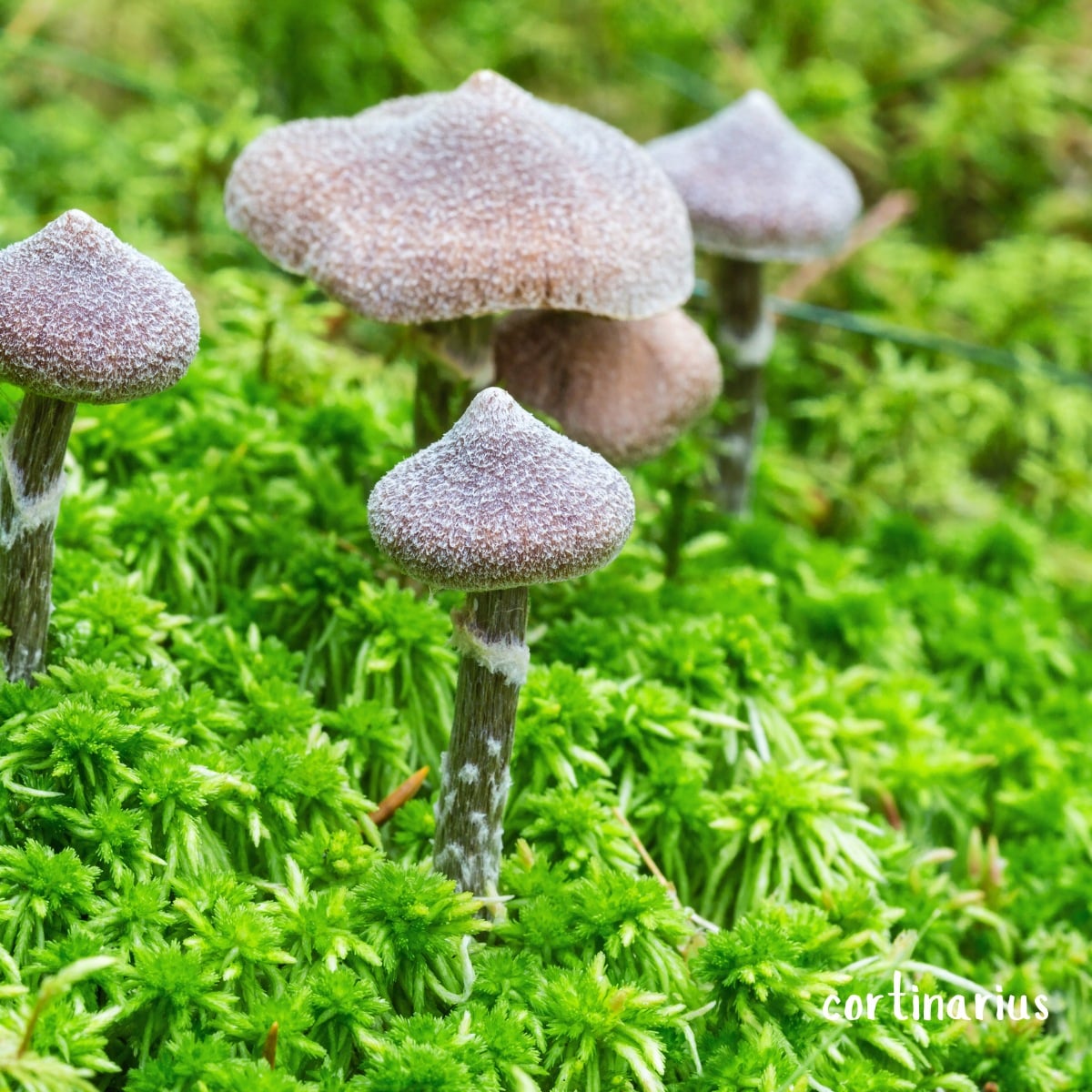
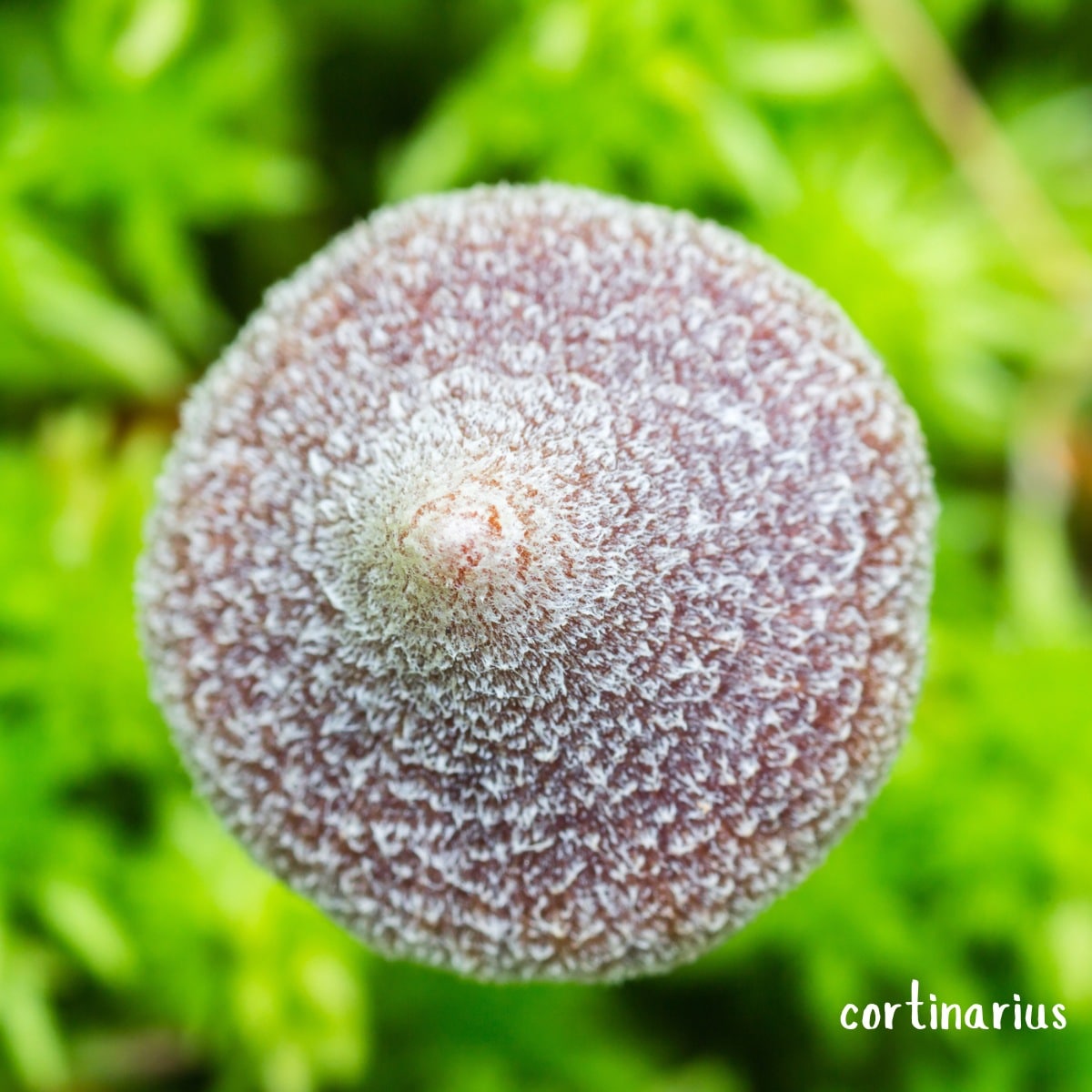
Frosty Webcap (Cortinarius hemitrichus)
The cap typically measures 0.8 to 2.4 inches (2-6 cm) in diameter. It starts out bell-shaped, then flattens out with age. The cap surface is distinctively fibrous, covered with fine, whitish veil remnants that give it a frosted appearance, especially along the edges. The cap color ranges from grayish-brown to ochre-brown, often with a slightly darker center. The gills are crowded and initially pale clay-colored but darken to rusty brown with age. The stem is slender and cylindrical, often with a slightly bulbous base. It shares the cap’s coloration and is adorned with silky fibrils, sometimes forming incomplete rings or zones. The flesh is thin and pale, with a mild taste and a slightly radish-like odor.
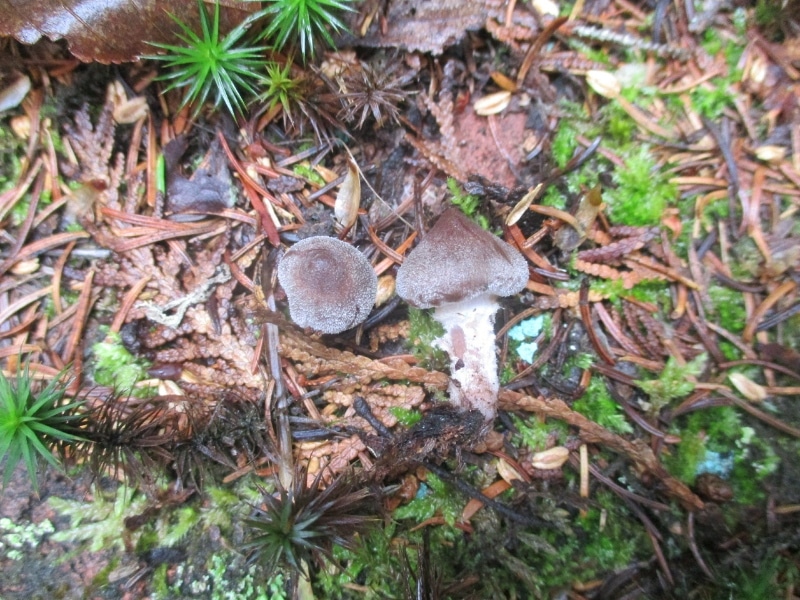
Surprise Webcap (Cortinarius semisanguineus)
Also known as the red-gilled cort, this mushroom has vibrant blood-red gills that contrast sharply with the dull brown cap. Its cap typically measures between 1 and 2.5 inches in diameter and is rounded with a slight umbo or central bump. The cap color ranges from yellowish-brown to cinnamon-brown, sometimes with reddish tones. The gills are closely spaced and attached to the stem. The stem itself is slender and usually the same color as the cap or slightly paler, often with reddish fibrils or streaks. This mushroom is found in coniferous and mixed forests, often growing in association with pine trees.
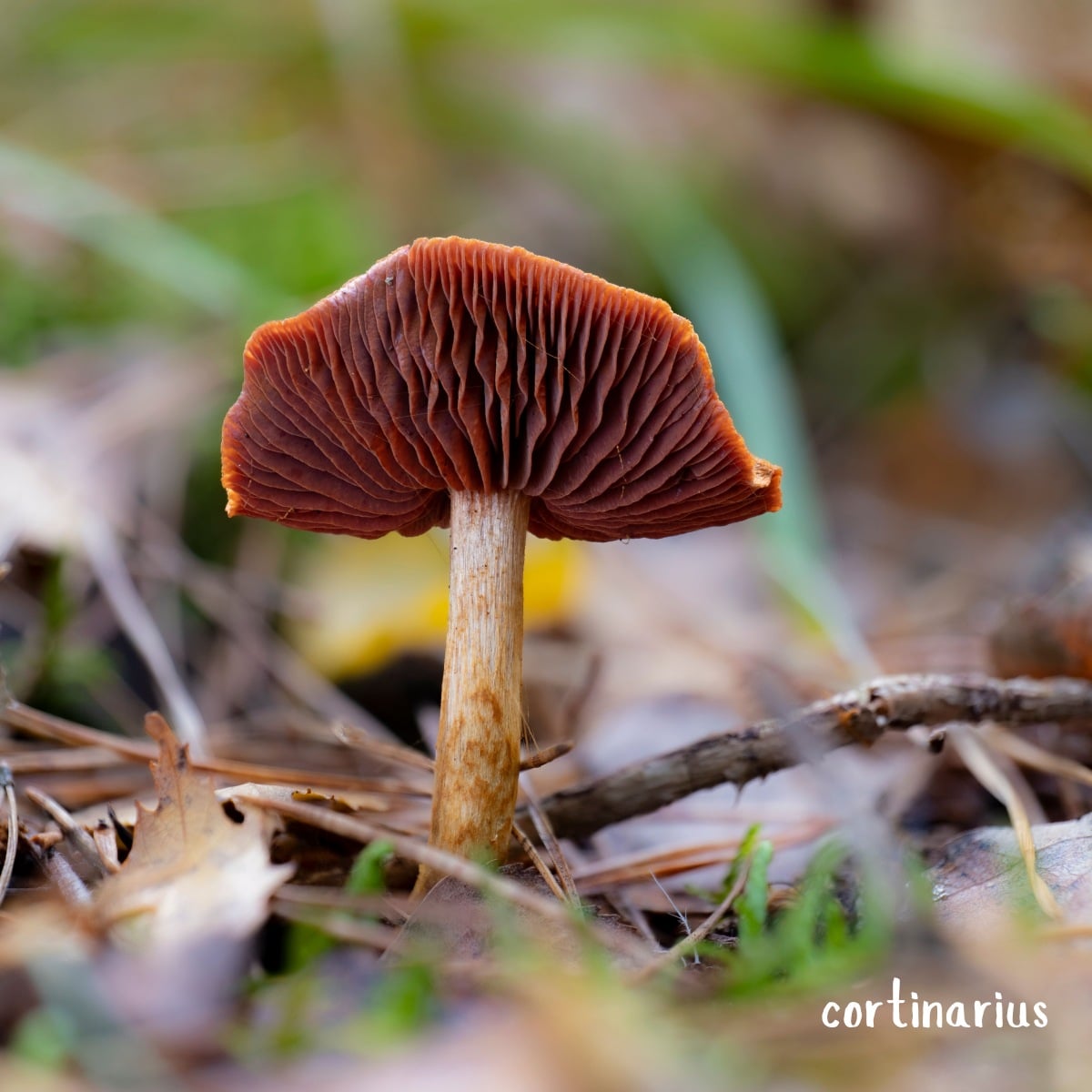
Cortinarius Lookalikes
One of the primary challenges in identifying Cortinarius mushrooms is their resemblance to other species, particularly edible ones. Some Cortinarius species can be mistaken for edible mushrooms like blewits or honey mushrooms. This similarity poses a significant risk since some Cortinarius species are highly toxic and even lethal. Cortinarius species have rusty brown spores, blewits have pale pink spores, and honey mushrooms have white spores.
This is a great tool for differentiating mushrooms with light spore prints like honey mushrooms. However, some edible lookalikes also have dark spore prints that may be confusing depending on how well you are able to differentiate between colors. For example, Agaricus species have chocolate brown spore prints. Edible Stropharia species have purple-black spore sprints. The difference between chocolate brown, purple-black, and rust-brown is noticeable, but you have to be paying close attention!
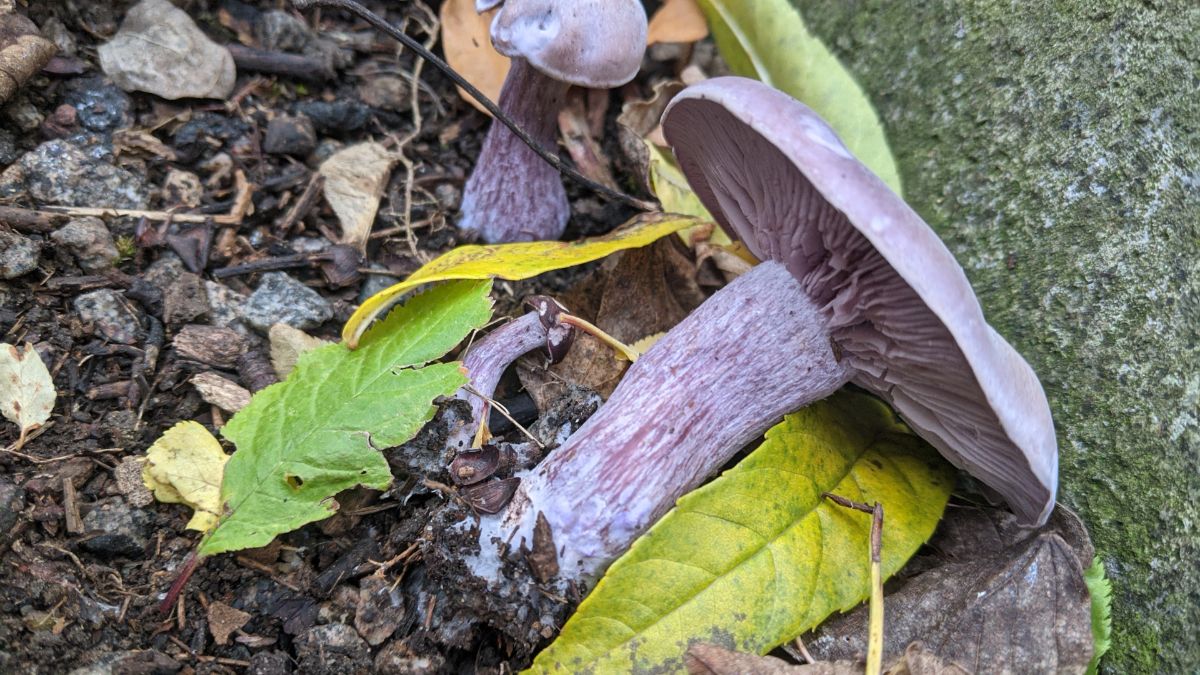
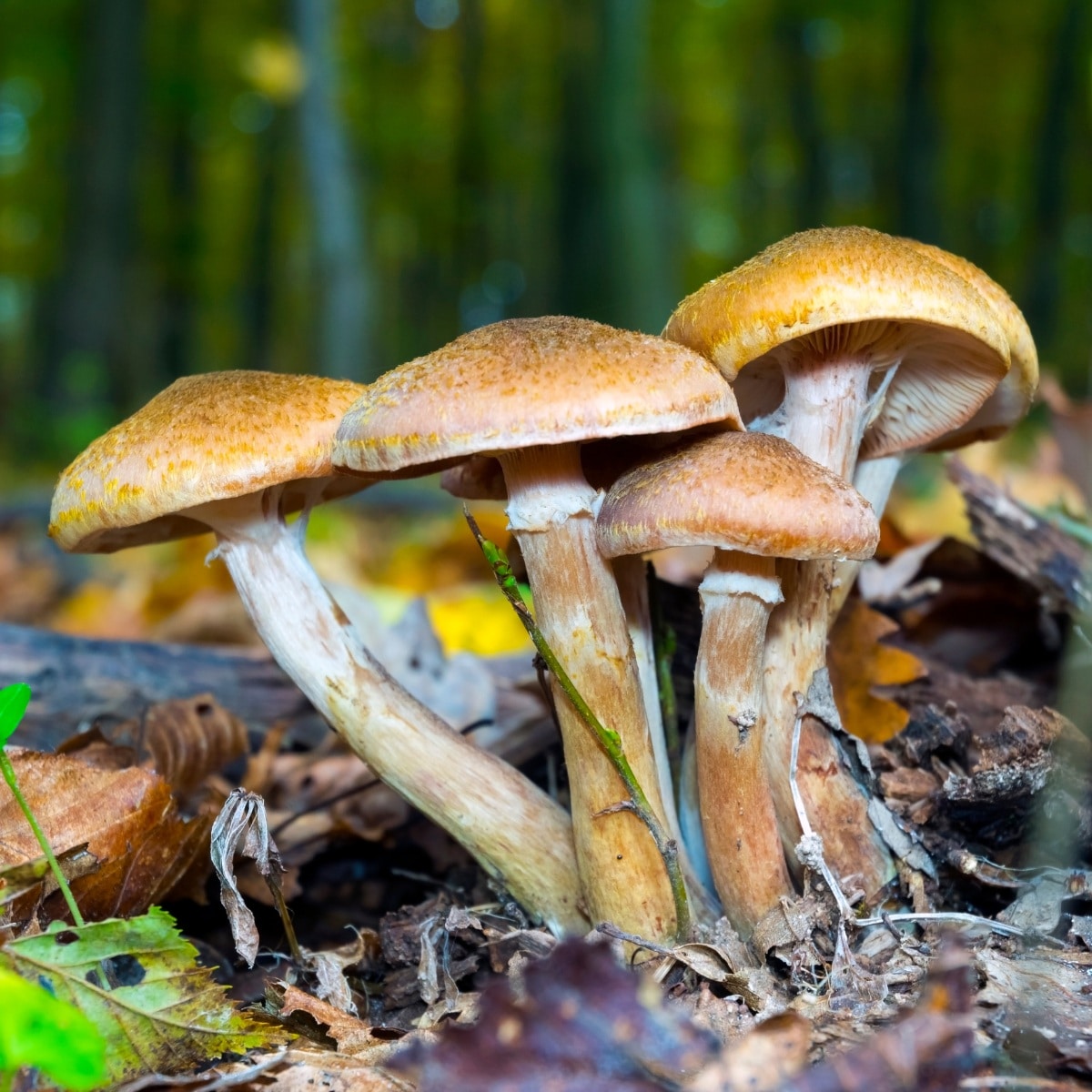
Mushroom hunters seeking “Laughing Gyms” (hallucinogenic Gymnopilus species) face the highest risk of deadly Cortinarius poisoning. Many Gyms look alarmingly similar to Corts and toxic Galerina mushrooms.
Cortinarius species have “rusty brown” spore prints, while Gymnopilus produce “orange to orange-brown to rusty” prints. For most people, telling these colors apart is tricky. While Gymnopilus grows on wood and Cortinarius on the ground, buried wood or decayed matter can blur this distinction.
We don’t recommend it, but if you’re hunting Gymnopilus to eat, be extremely careful. Besides looking like Corts, Gyms can be confused with Pholiota (some cause illness) and deadly Galerina mushrooms. Both Pholiota and Galerina grow on wood, making them even more similar. Galerina also has “rusty brown” spore prints, adding to the confusion.
To differentiate between lookalikes, it’s crucial to consider multiple characteristics:
Key Cortinarius Features:
- Presence of a cortina: The web-like veil covering young Cortinarius gills is distinctive.
- Ring around the stem: Once the cortina breaks, a ring is left around the upper stem. Sometimes, there is a skirt or “boot,” but there is always some type of marking, like a high tide water line.
- Growth habit: Wepcaps only grow on the ground, never from wood or trees. They grow in association with certain tree species, so there will always be trees around (you won’t find them out in the middle of a meadow or lawn).
- Spore print: The spore print of a webcap mushroom is always rusty brown.
- Gills: The gills are also usually rusty brown in maturity (but not always).
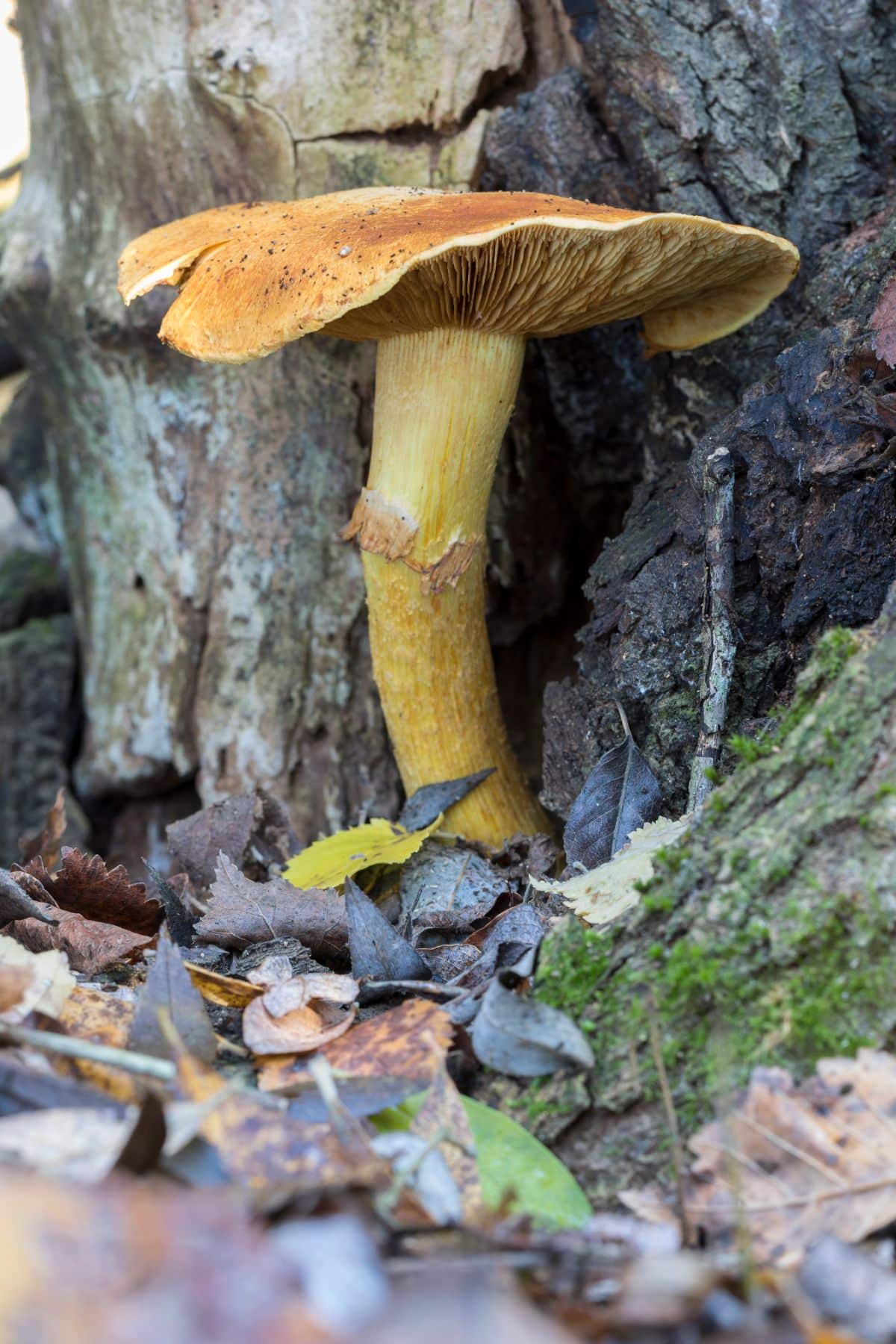
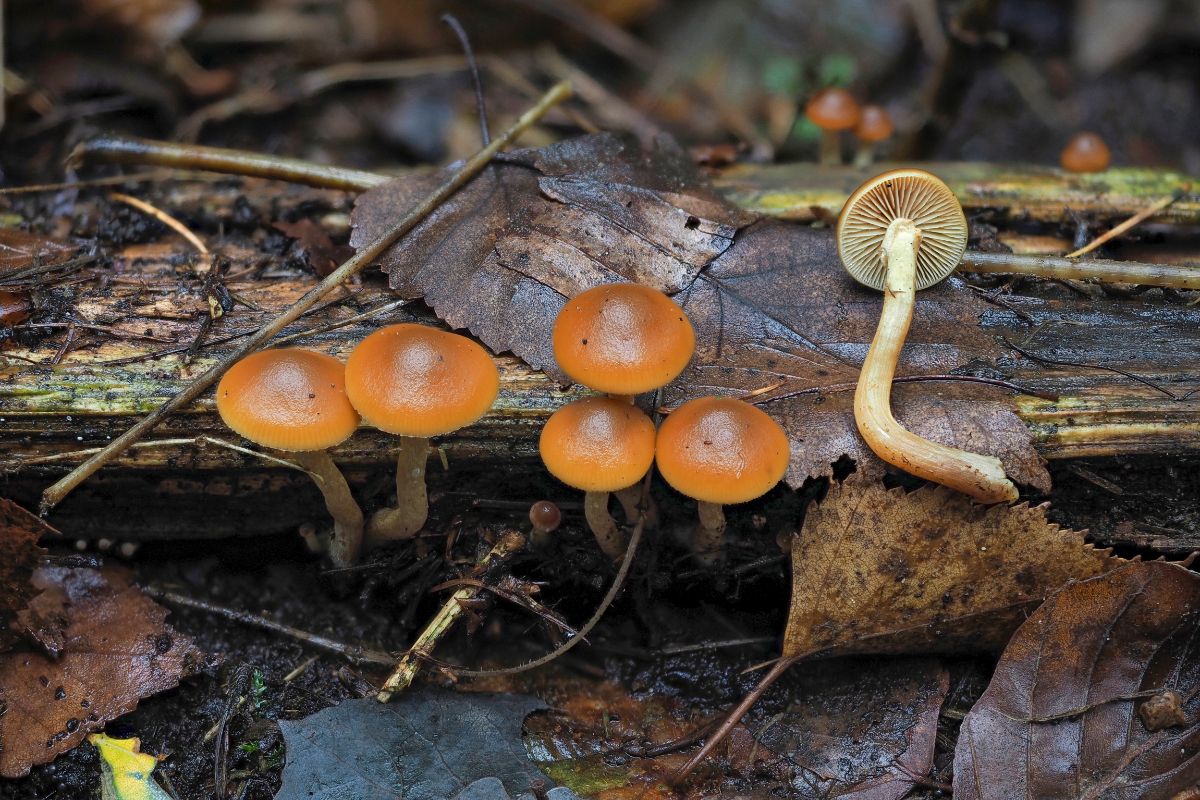
Dyeing With Cortinarius Mushrooms
Cortinarius mushrooms are popular among natural dye enthusiasts for their ability to produce a wide range of vibrant colors. Several species yield particularly striking results.
- Cortinarius semisanguineus, also called the surprise webcap, is renowned for its ability to create rich red and orange hues.
- Cortinarius sanguineus, the bloodred webcap, produces deep crimson to blood-red shades.
- Cortinarius archeri, found in Australia and New Zealand, offers a palette of yellow to green colors.
- Cortinarius purpurascens can produce purple to blue-violet shades
- Cortinarius cinnamomeus gives warm, cinnamon-brown tones.
- Cortinarius croceus produces beautiful yellow to golden-yellow
- Cortinarius archeri makes green or olive-green
- Cortinarius austrovenetus also makes green to olive green colors
- Cortinarius phoeniceus produces lots of reds to reddish-brown
- Cortinarius malicorius creates deep oranges and rusty orange
- Cortinarius uliginosus makes brown to reddish-brown
- Cortinarius smithii produces yellow to golden-yellow
The process of extracting these colors typically involves simmering the mushrooms in water, then adding mordants like alum to help fix the dyes. The exact shade and intensity of the colors can vary depending on factors such as the age of the mushroom, the mordant used in the dyeing process, and the type of fiber being dyed. Additionally, some of these mushrooms may produce different colors on different types of fibers (e.g., wool vs. silk).
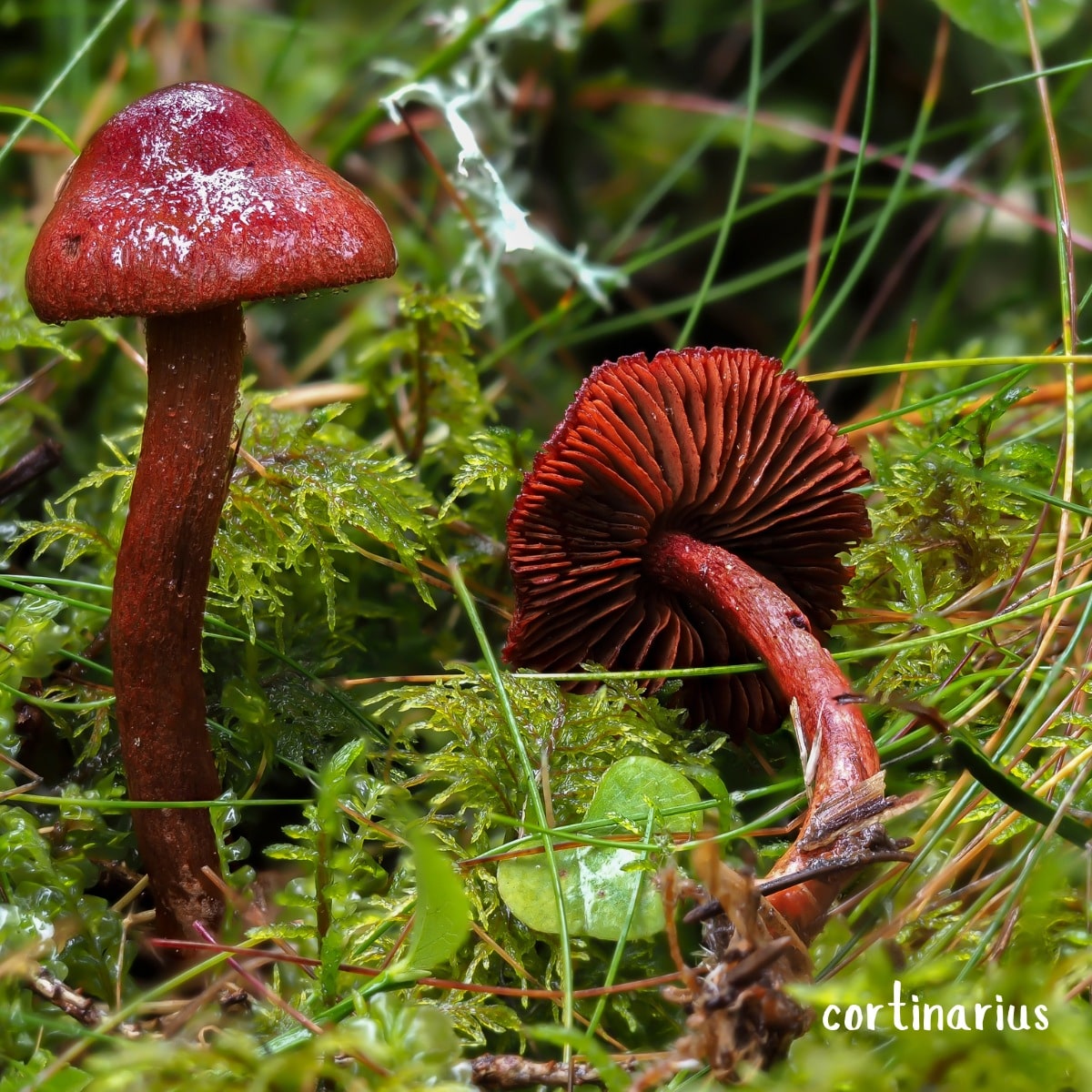
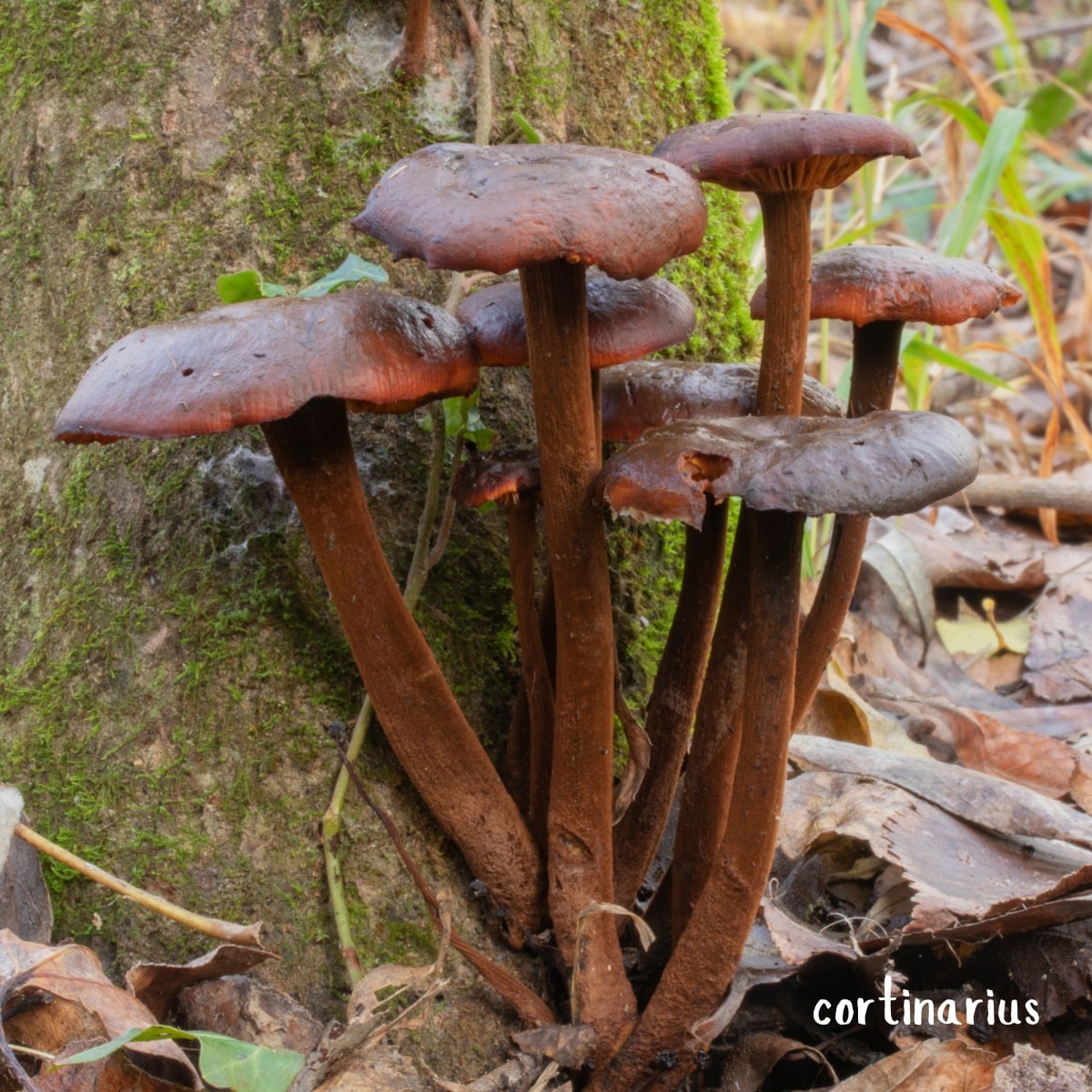
Common Questions About Cortinarius Mushrooms
How many species of Cortinarius are there?
There are over 2,000 known species of Cortinarius. It is one of the largest genera of mushrooms.
Are Cortinarius mushrooms edible?
Most Cortinarius species are not edible. Some are known to be poisonous, and many others have unknown edibility. It’s best to avoid eating any Cortinarius mushrooms unless you are an expert.
Are there any dangerous Cortinarius species?
Yes, some Cortinarius species are known to be dangerous. For example, Cortinarius rubellus and Cortinarius orellanus contain the toxin orellanine, which can cause kidney failure
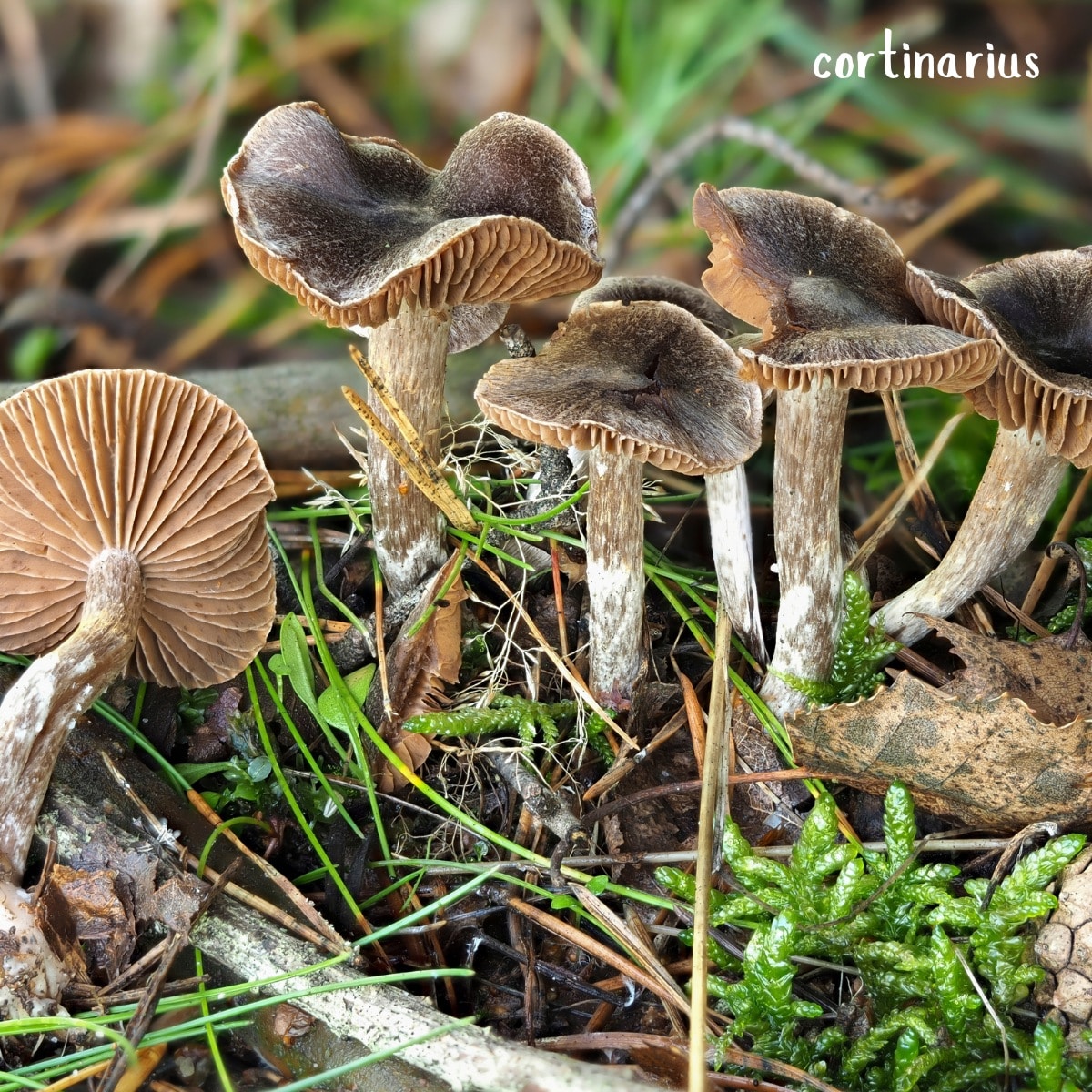






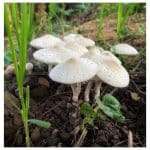
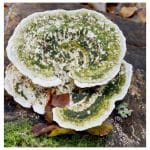
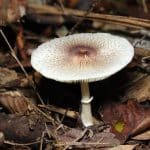
Leave a Reply